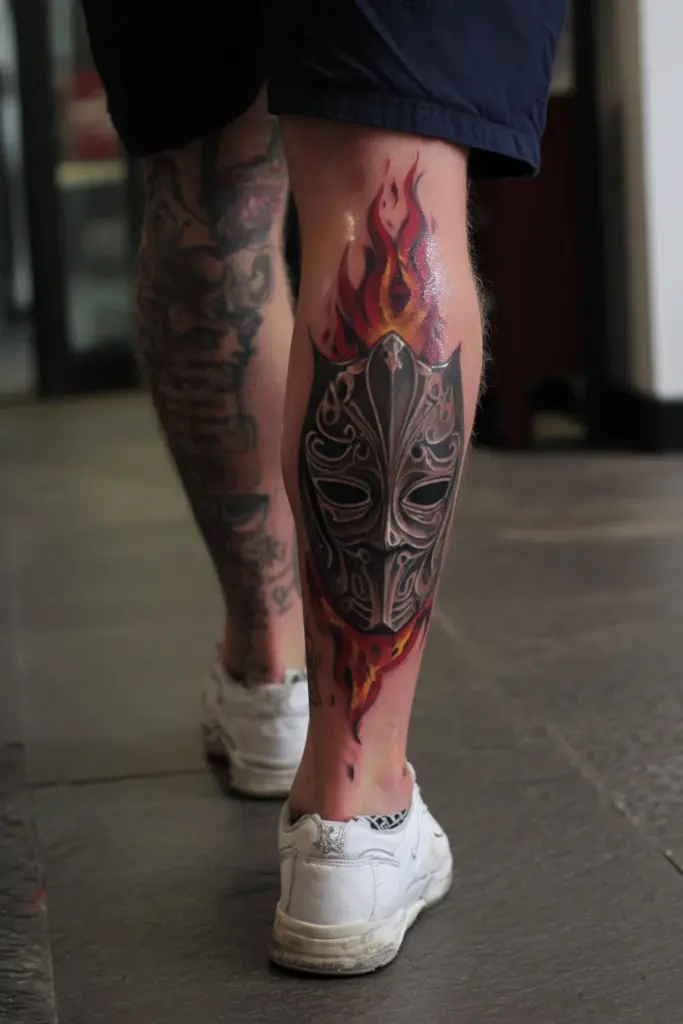Im Hakan, a tattoo consultant and designer with 10+ years of experience in modern tattoo culture. In this post I showcase 24 leg tattoo images and walk you through design choices, placement, pain expectations and aftercare tailored for men. Leg tattoos suit men who want visible yet versatile art – from discreet calf pieces to bold full-thigh and full-leg sleeves. Whether youre into realism, blackwork, neo-traditional, Japanese or tribal styles, Ill explain what works best for muscle shape, hair patterns and lifestyle. Practical tips include matching design scale to calf and thigh anatomy, choosing contrast for darker skin or heavy hair, scheduling sessions for endurance, and managing healing with compression and movement. Expect honest advice on pain, session length, and how to communicate ideas to your artist so you get a leg tattoo that lasts and looks great.
Ornamental Mandala Calf Tattoo — Geometric Blackwork with Winged Motif
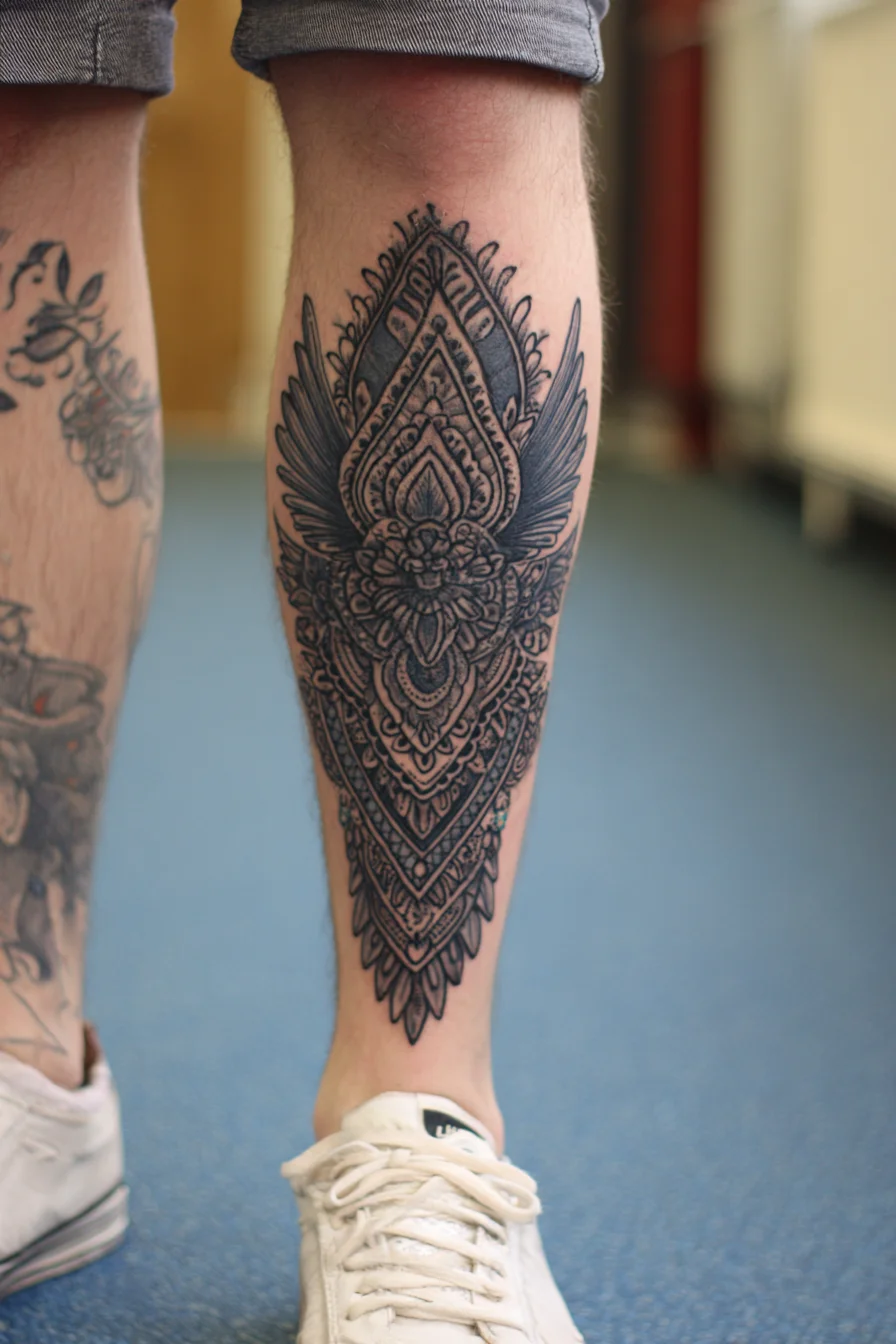
This vertically oriented ornamental mandala blends layered geometry, floral filigree and subtle wing elements to convey balance, protection and forward motion—qualities many men choose to express through leg pieces. The design reads well on the lower calf where its elongated shape follows muscle lines and remains visible with shorts or rolled pants. Pain expectations: outer calf and fleshy portions are generally low-to-moderate in discomfort; closer to the shin, behind the knee or inner calf you can expect sharper sensitivity. Size considerations: the pattern benefits from a medium-to-large scale so fine dotwork and repeating motifs stay crisp — plan to cover most of the calf length or at least 50–70% of the circumference for impact. Expect 1–3 sessions depending on detail and shading. Styling variations: solid blackwork and heavy linework give a bold, masculine look; dotwork and stippling emphasize texture; introduce muted color washes or gold highlights for contrast; or integrate into a half- or full-leg sleeve with complementary geometric or neo-traditional pieces. Discuss spacing, contouring and aftercare with your artist to ensure longevity and clarity of lines.
Biomechanical Skull Calf Tattoo with Realistic Roses — Black & Grey Realism
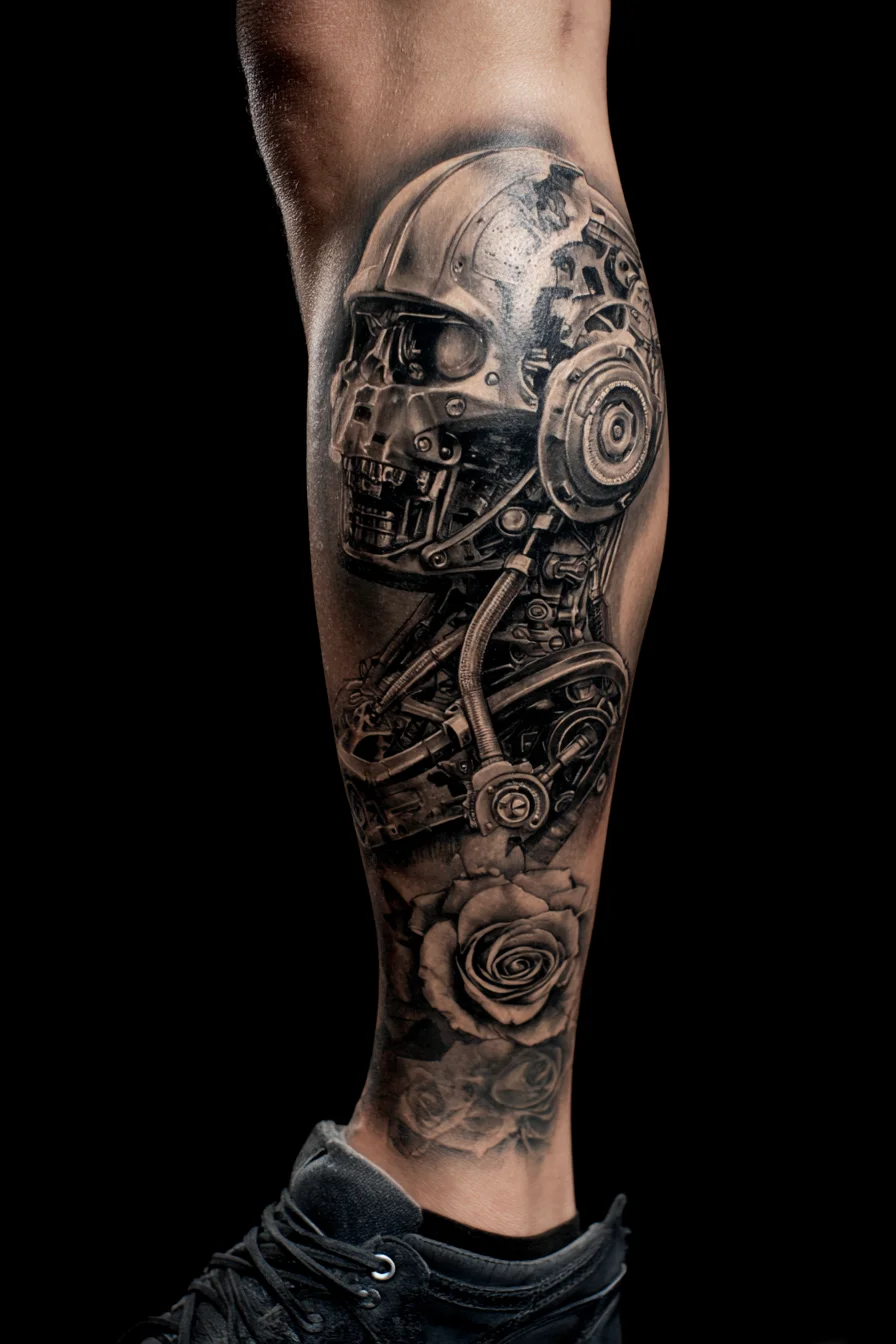
This calf tattoo blends a biomechanical skull with photorealistic roses to create a masculine contrast between machinery and organic life. The design reads as resilience and duality — strength and mortality paired with beauty and rebirth — making it a strong choice for men who want a statement piece rooted in symbolism. Placement suggestions: the outer or full calf is ideal for showcasing vertical detail and preserving shape when wearing shorts; the design can also wrap slightly toward the shin or be extended up the thigh for a larger composition. Pain expectations: the outer calf is a moderate-pain area with good muscle padding; expect increased sensitivity near the inner calf, behind the knee and over the shin bone. Size considerations: to retain the small mechanical parts and realistic rose shading, aim for a medium-to-large canvas (minimum 6–8 inches vertically); highly detailed realism benefits from larger scale and slower sessions. Styling variations: classic black-and-grey realism, selective color accents (deep red roses), negative-space highlights, or a mixed neo-traditional/biomech approach. Plan multiple sessions for depth, and discuss aftercare and touch-ups with your artist.
Blackwork Calf Tattoo — Urban Map & Geometric Shin Sleeve
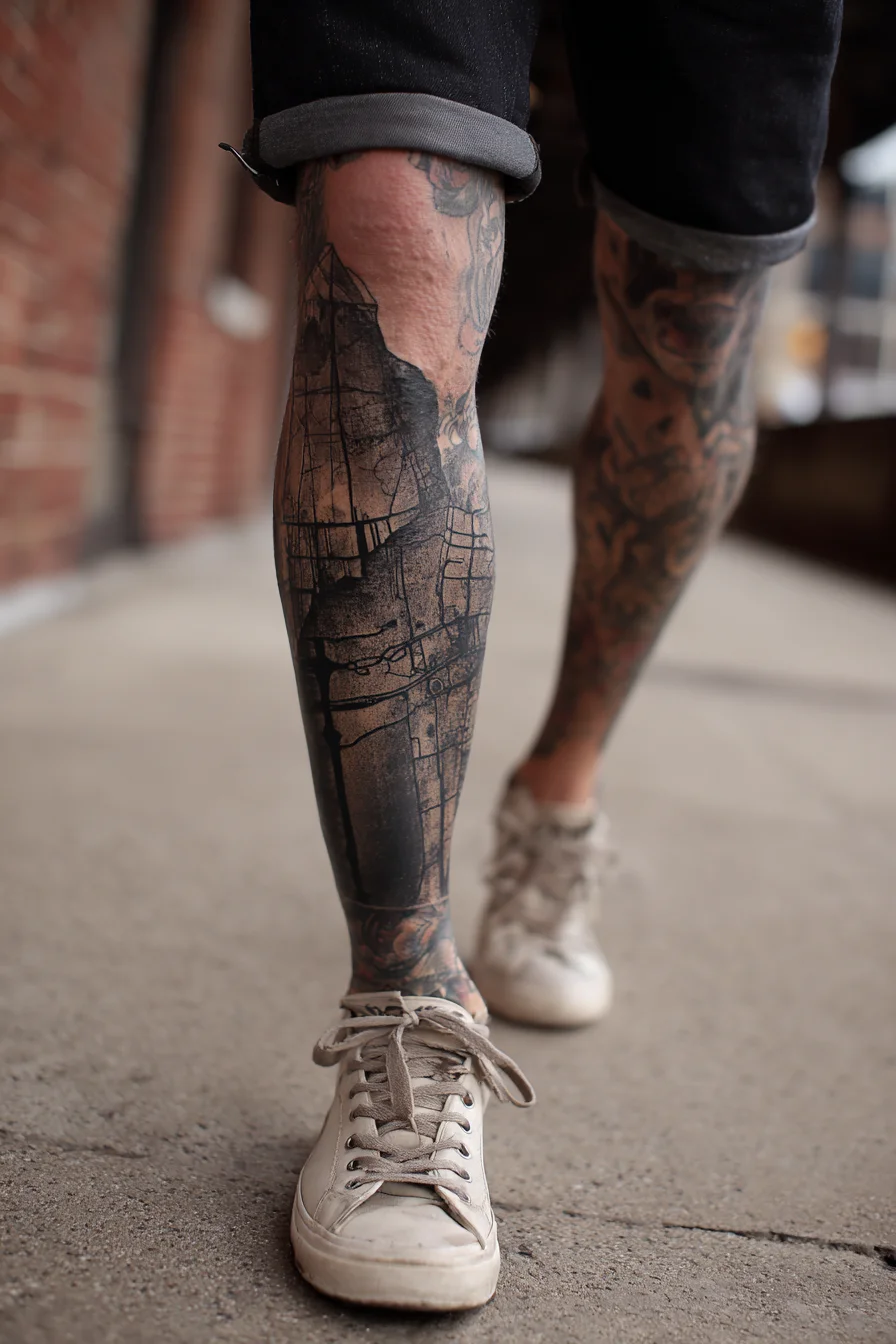
This blackwork calf design reads like an urban map — layered grids, architectural lines and distressed fills that symbolize navigation, roots and the structure of personal journeys. Its vertical composition suits the lower leg, delivering a bold, masculine silhouette. Placement suggestions: ideal on the outer or full calf where muscle provides a smooth canvas; a wrapped, full-calf piece or extended shin sleeve integrates well with existing leg tattoos. Avoid thin areas near the ankle if you want to preserve fine-line detail. Pain expectations: calf flesh is medium-tolerant — expect moderate discomfort during long sessions; the shin and boney ankle are more sensitive, so plan breaks and staggered sessions if extending over bone. Size considerations: to retain crisp map detail, aim for at least 15–25 cm (6–10 in) in height and a proportionate width; smaller scales will lose line work and texture. Ask your artist about line weight, spacing and needle selection. Styling variations: dense blackwork, intentional negative space, dotwork shading, or muted color accents (sepia/olive) can personalize the piece; pair with script, compass or geometric fillers to reinforce meaning. Discuss staging and aftercare with your artist for best healing and longevity.
Tribal Polynesian Calf Shield Tattoo — Masculine Blackwork Spear Motif
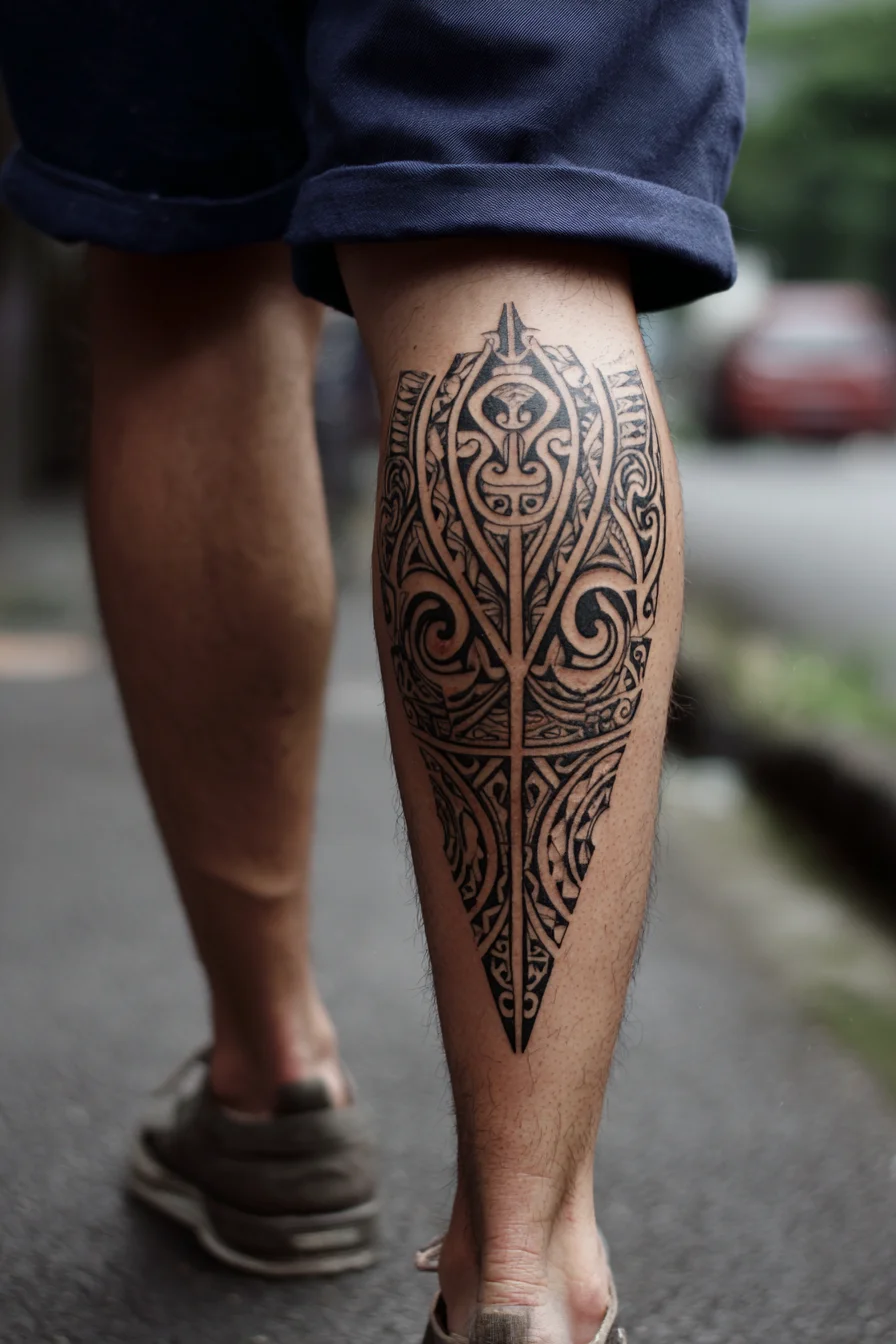
This bold Polynesian-inspired calf tattoo reads like a protective shield and spear, with interlocking koru and tribal filigree that symbolize strength, ancestry and a warrior’s journey. Designed for men who want a masculine, statement piece, the elongated triangular layout naturally follows the calf’s contours to create movement whether standing or walking. Placement suggestions: center or outer lower calf for visibility and muscular flow; inner calf for a more private placement; the same vertical motif can be adapted for the shin, forearm or integrated into a leg sleeve. Pain expectations: calf work is generally moderate — the fleshy outer calf is among the more comfortable areas, while the inner calf, tibia/ankle and behind-the-knee regions are significantly more sensitive. Size considerations: preserve intricate detail by keeping a minimum width around 8–10 cm and a vertical length that fills the calf; reducing the design too much will cause line loss and muddying over time. Styling variations: bold blackwork for high contrast, fine-line or dotwork for subtler texture, deliberate negative space, or selective color accents (deep red, teal) to modernize while honoring the traditional feel. Consult your artist for stencil placement and tailored aftercare.
Lion-Leopard Calf Tattoo — Black & Grey Realism with Dotwork
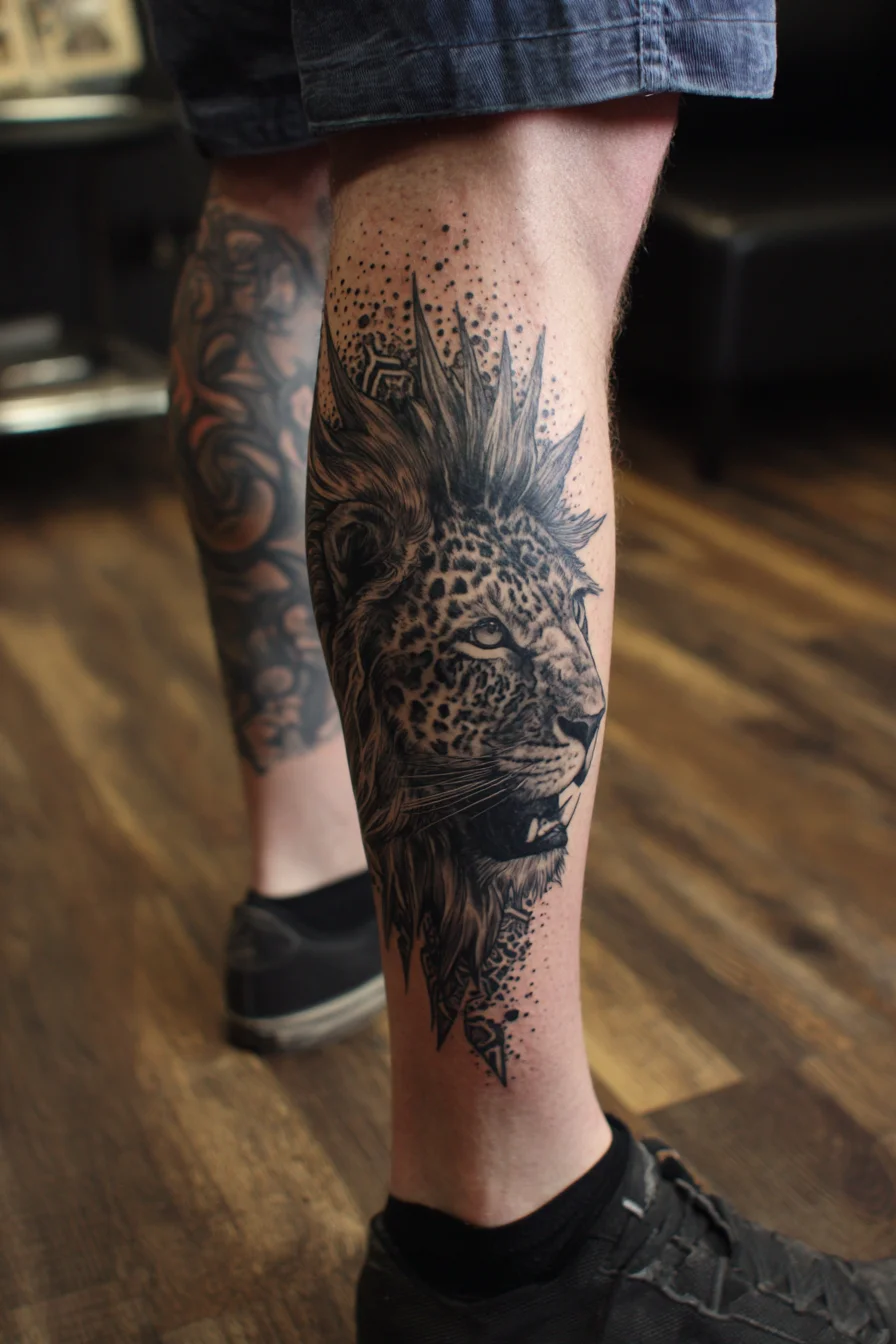
This calf tattoo blends a lions profile with leopard spotting in a black-and-grey realistic and dotwork composition, symbolizing strength tempered by stealth and adaptability. For men seeking a bold yet refined statement piece, the design reads masculine and dynamic while offering narrative depth. Placement: the outside calf shown is ideal—large, relatively flat surface that’s easy to conceal or display; alternatives include the upper arm, chest, or integrated sleeve/back for larger projects. Pain: expect moderate discomfort on the calf; fleshy, muscular areas tolerate longer sessions better than bony zones like the shin or ribs. Sessions commonly run 2–4 hours depending on shading and detail. Size: preserve facial detail and fur texture by keeping the piece medium-to-large (roughly 6–12 inches or larger); smaller scales will lose fine stippling and whisker lines. Styling variations: keep it pure black-and-grey realism with dotwork for a classic look, add selective color (amber eyes or warm mane highlights) for contrast, or integrate geometric/tribal elements to suit personal motifs. Discuss line weight and skin tone with your artist to ensure long-term legibility.
Ornate Compass & Map Calf Tattoo — Direction, Travel, and Resilience
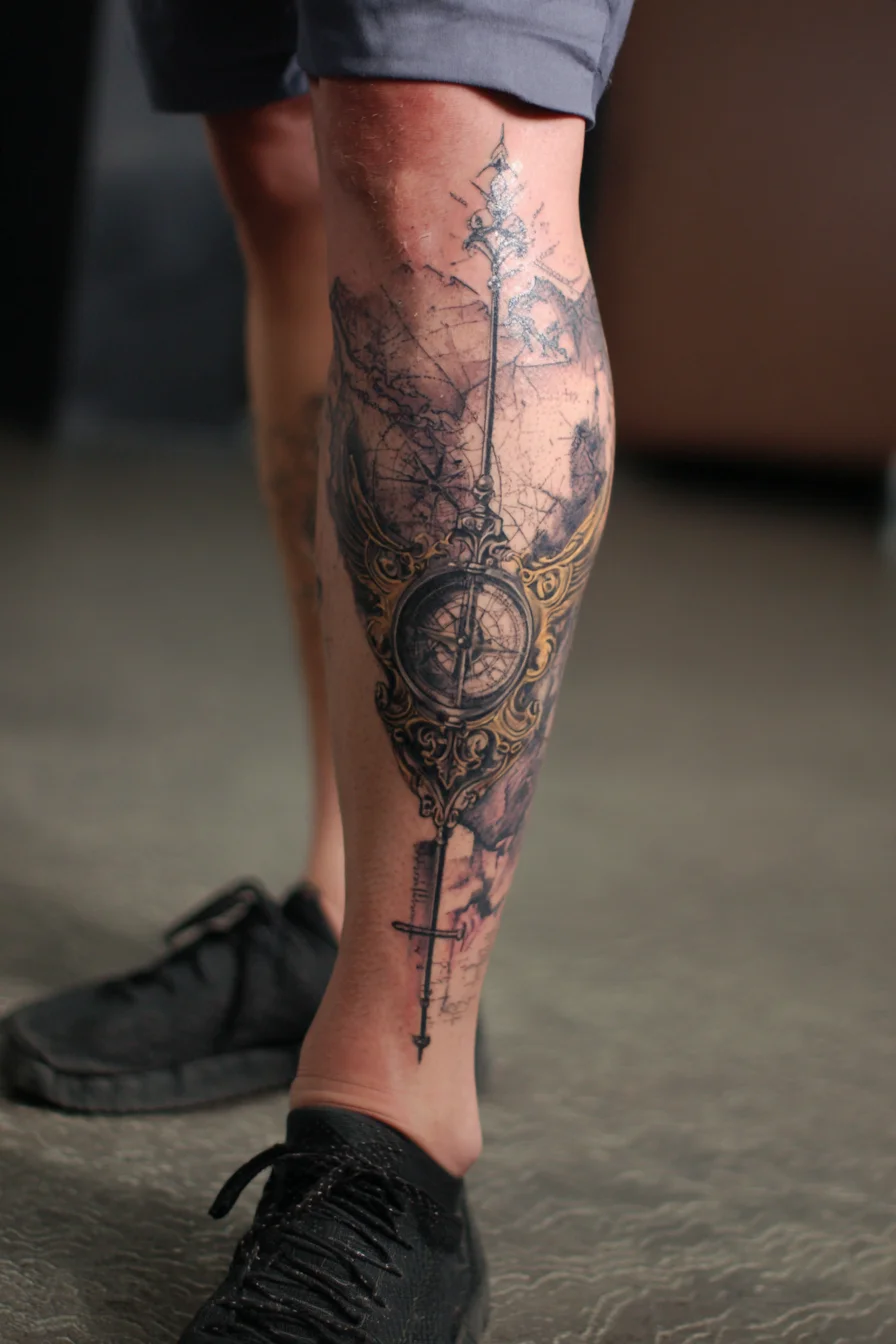
This vertical ornate compass and map tattoo reads as a masculine emblem of direction, travel, and personal purpose. The compass at the center suggests guidance and resilience, the vintage frame and subtle map background add a weathered explorer aesthetic ideal for men who value journey and intent. Placement suggestions: outer or full calf (as pictured) for visibility and flow; wrap or extend toward the shin, ankle, or upper thigh for a longer composition; outer forearm or ribcage are alternatives if you prefer an arm or torso placement. Pain expectations: calf flesh is generally moderate in discomfort — outer calf is among the easier spots, while the inner calf, shin bone, and ankle areas will increase sensitivity. Size considerations: keep this design medium to large (roughly 6–12+ inches vertically) so the ornate details and compass points remain crisp; scaling down risks losing filigree and map linework. Styling variations: solid blackwork or neo-traditional brass/gold highlights, dotwork map shading, watercolor washes for the background, or geometric simplification for a bolder masculine look. Note: metallic inks and fine detail need occasional touch-ups and rigorous sun protection to maintain contrast.
Ornamental Filigree Calf Tattoo — Blackwork Baroque Leg Piece
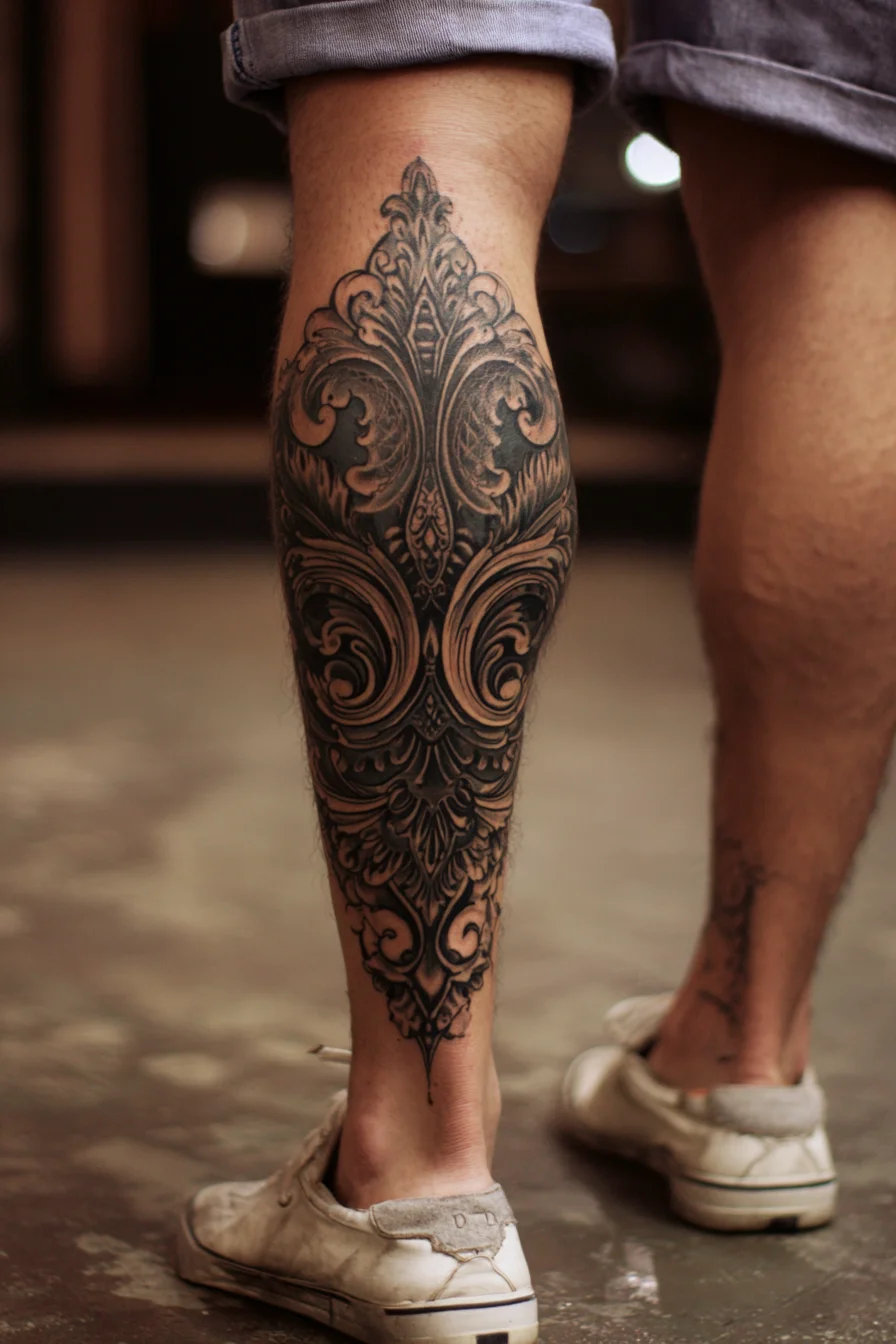
This ornamental filigree calf tattoo channels Baroque and classical scrollwork into a bold blackwork statement piece. The design reads as both decorative and emblematic — symmetry and layered shading evoke strength, discipline, and refined taste without overt imagery. Placement on the outer or central calf suits the elongated, tapered composition, or it can wrap slightly around the muscle for a three-dimensional effect; it also pairs well with ankle, shin, or thigh extensions to form a cohesive lower-leg sleeve. Expect moderate pain: the calf offers good muscle padding so sessions are generally tolerable, but sensitivity increases near the Achilles, behind the knee, and close to bone. Size matters for leg filigree — larger scales (covering most of the calf) preserve fine detail and smooth shading, while smaller pieces require simplification of curls and negative space. Styling variations include pure blackwork, dotwork texture, increased negative-space highlights, subtle color accents (deep sepia or muted gold), or integration with geometric or tribal elements for a more masculine edge. Plan multiple sessions for full shading and consult your artist on line weight to maintain longevity.
Black & Grey Urban Rain Cityscape Calf Tattoo — Walking Figure Design
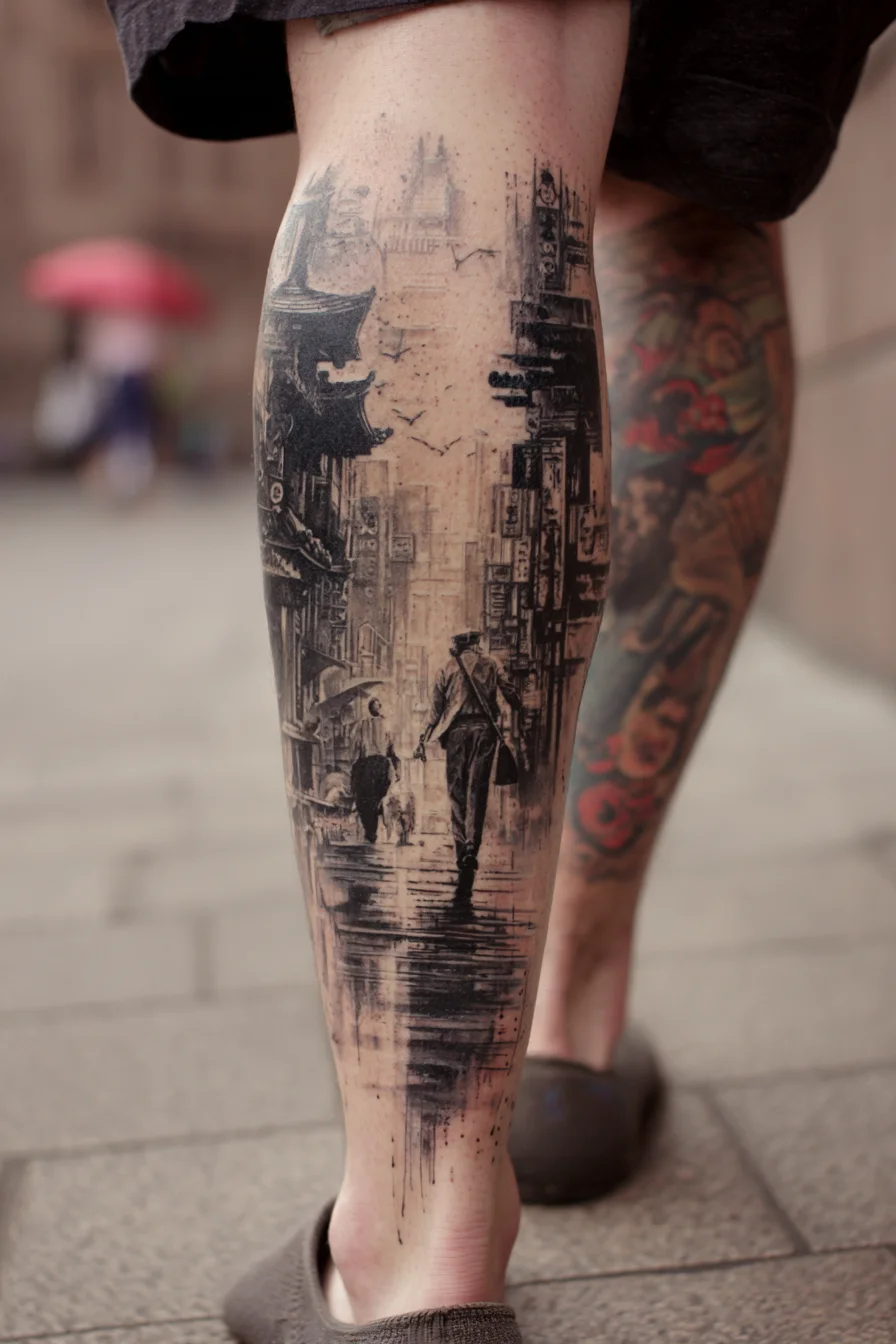
This vertical black-and-grey cityscape captures a lone figure walking through a rainy street — a strong visual for themes of solitude, journey, memory and quiet resilience. For men who want a narrative piece, it reads as a cinematic moment: perseverance through motion and reflective nostalgia. Placement suggestions: the calf is ideal for the elongated composition shown, with the outer calf offering lower pain and better healing; alternative sites include the outer forearm, thigh or side rib if you want a larger or more private canvas. Pain expectations: expect moderate discomfort for shaded realism — outer calf and thigh are among the less painful areas, while shin, ankle and ribs run higher; long, detailed shading usually requires multiple sessions. Size considerations: keep this design medium-to-large (roughly 6–10 inches / 15–25 cm tall) to preserve fine detail and reflection work; very small versions will lose depth. Styling variations: true black-and-grey realism (as pictured), selective color accents (a red umbrella or neon signage), watercolor backwash, high-contrast silhouette or dotwork textures. Consult a realism specialist, bring reference images and plan for 2+ sessions for best results.
Steampunk Mechanical Calf Tattoo — Gears, Chains & Biomechanical Detail
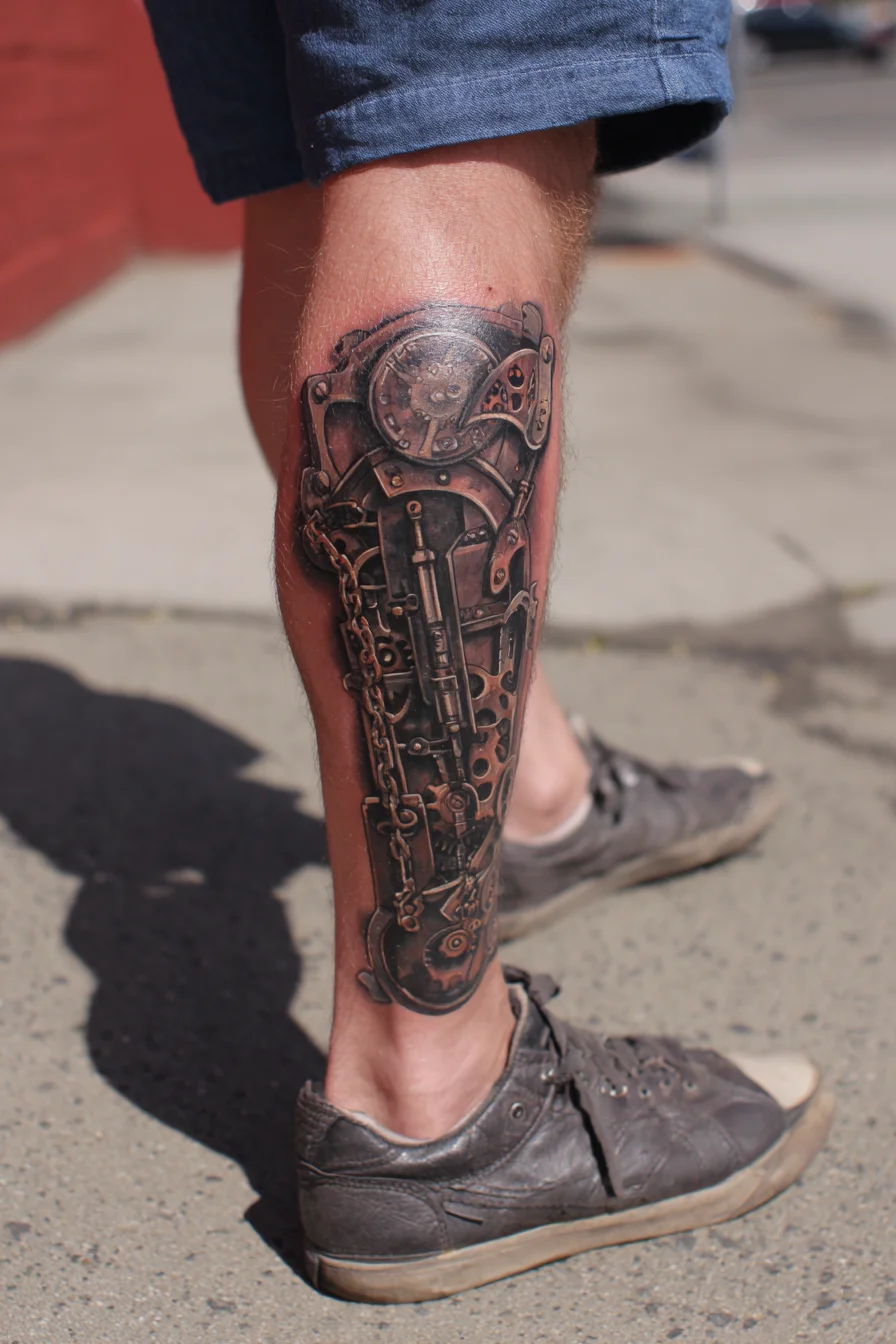
This mechanical/steampunk calf piece blends realistic gears, chains and pistons to symbolize time, resilience and the organized inner drive many men like to represent in body art. As a placement, the calf is ideal: it provides a flat, muscular canvas for long vertical compositions, offers moderate pain during inking, and is easily shown or concealed. Expect moderate discomfort — the fleshy outer calf is tolerable for most, while areas near the shin, ankle or behind the knee are significantly more sensitive and may require breaks. For detail clarity choose a medium-to-large size (roughly 6–12 inches / 15–30 cm) so gears, screws and texture hold up over time; very small versions will lose mechanical detail. Plan for multiple sessions if you want deep black shading, fine metal highlights or color washes. Styling options include black-and-gray photorealism for a rugged industrial look, bronze/copper color accents for steampunk warmth, or biomechanical blends that morph metal into flesh. Ask your artist for stencils that follow muscle lines and for a layered aftercare plan to protect crisp highlights and thin-line work.
Japanese Dragon Calf Tattoo — Fiery Calf Sleeve in Blackwork & Color
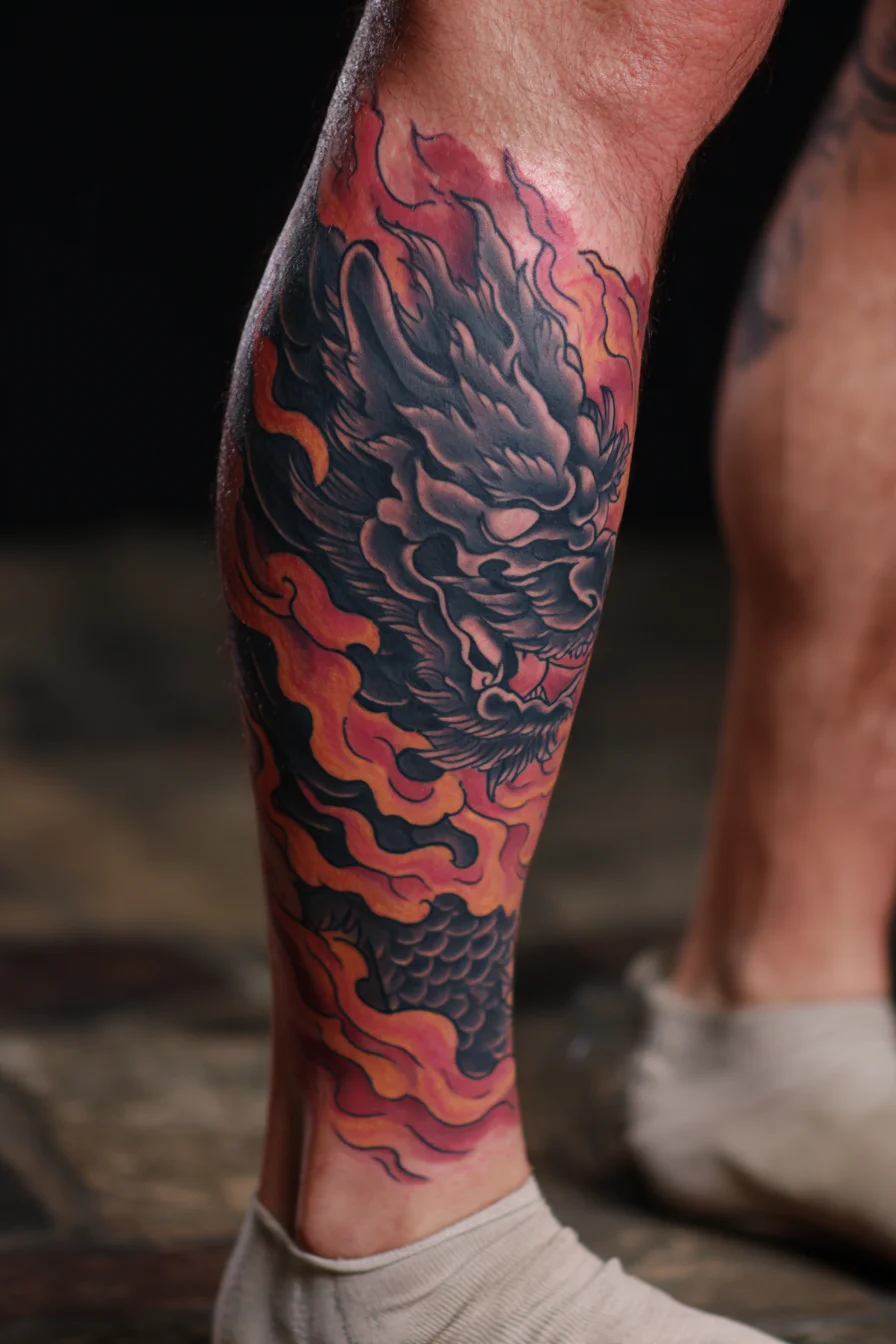
This bold Japanese-style dragon wrapped in flames conveys protection, resilience and controlled power — classic masculine themes suited to men who want a statement piece. The design reads well on the lower leg, using the calf’s natural curve to emphasize the dragon’s flow and motion. Placement suggestions: outer or medial calf for visibility, full lower-leg sleeve to the ankle or up toward the knee for maximum impact, or a wraparound piece that ties into a thigh or foot tattoo. Expect pain levels to be moderate overall; outer calf is one of the easier areas, while the inner calf, behind the knee and over the shin are more sensitive. Size considerations: larger canvases (6–12+ inches) allow for crisp scales, facial detail and saturated color work; small versions will lose texture and expression. Styling variations include pure blackwork for a stark look, full-color neo-traditional with vivid flames, or a more authentic Irezumi approach with cloud and wave backgrounds. Plan multiple sessions for linework, shading and color saturation, and discuss contouring with your artist to suit your muscle anatomy.
Newspaper Collage Calf Tattoo — Vintage Black & Grey Leg Piece for Men
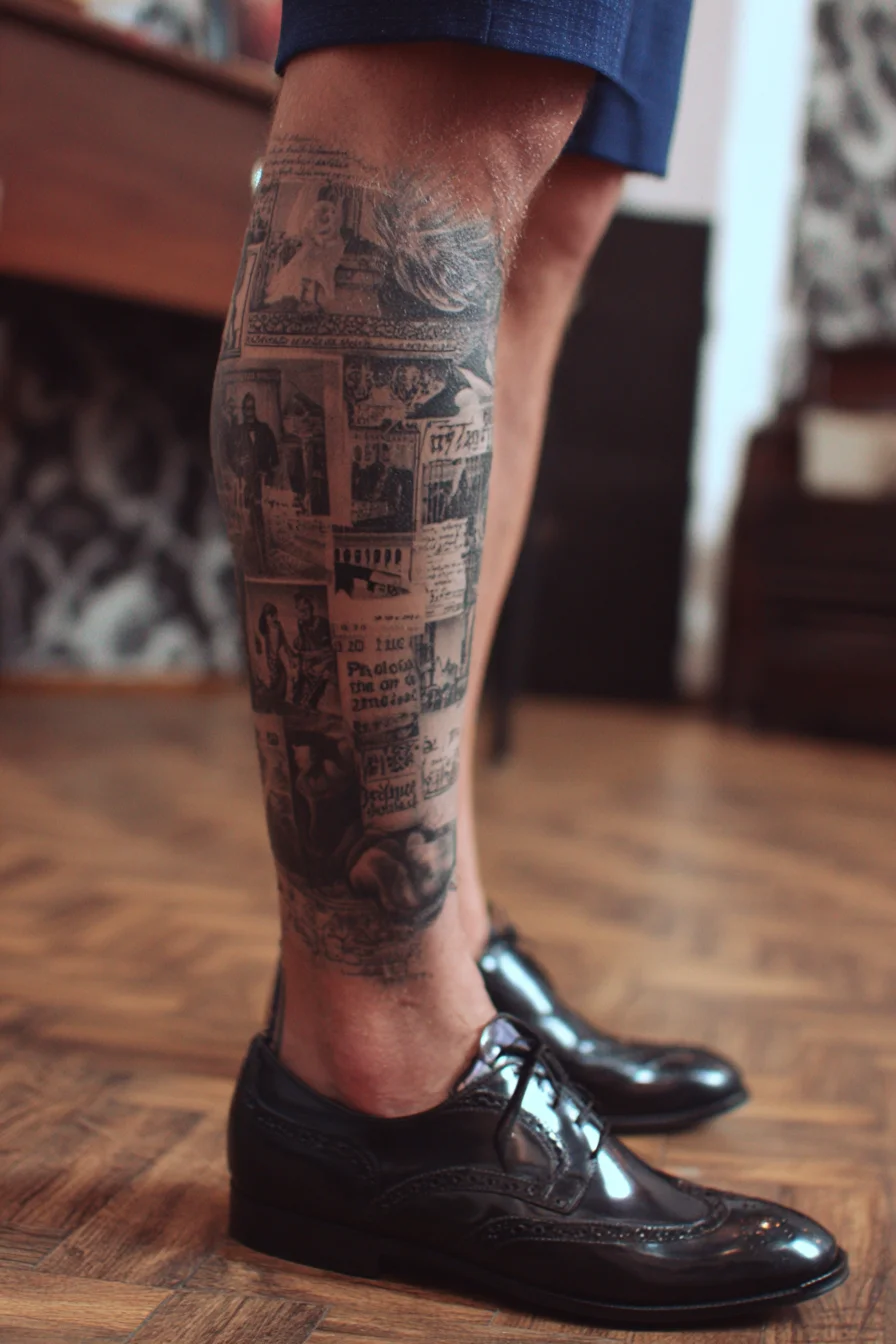
This newspaper-collage calf tattoo combines vintage ephemera, photographic panels and fine-line black-and-grey shading to create a narrative, masculine leg piece. Conceptually it reads like a personal archive — memories, headlines or cultural references — which makes it ideal for men who want a storyteller-style tattoo that still reads cleanly from a distance. Placement: the outer or lateral calf is recommended for visibility and muscle coverage; inner calf offers a more private option. Pain and session expectations: the bulk of the calf (gastrocnemius) is medium in pain due to thicker muscle and more flesh, while areas near the shin, ankle or behind the knee are noticeably more sensitive. Plan multiple sessions for dense detail — expect 1–4 sessions depending on size and intricacy. Size considerations: to preserve readable text and small images, opt for a medium-to-large layout (at least 8–10 cm wide and 15–25 cm tall) or simplify elements if going smaller. Styling variations: keep high-contrast blackwork for longevity, add sepia or muted color accents for a vintage feel, or break panels into negative-space frames for a modern twist. Discuss skin tone, hair removal and realistic aging with your artist before booking.
Rose & Mechanical Pocket Watch Calf Tattoo — Timeless Floral Gear Design
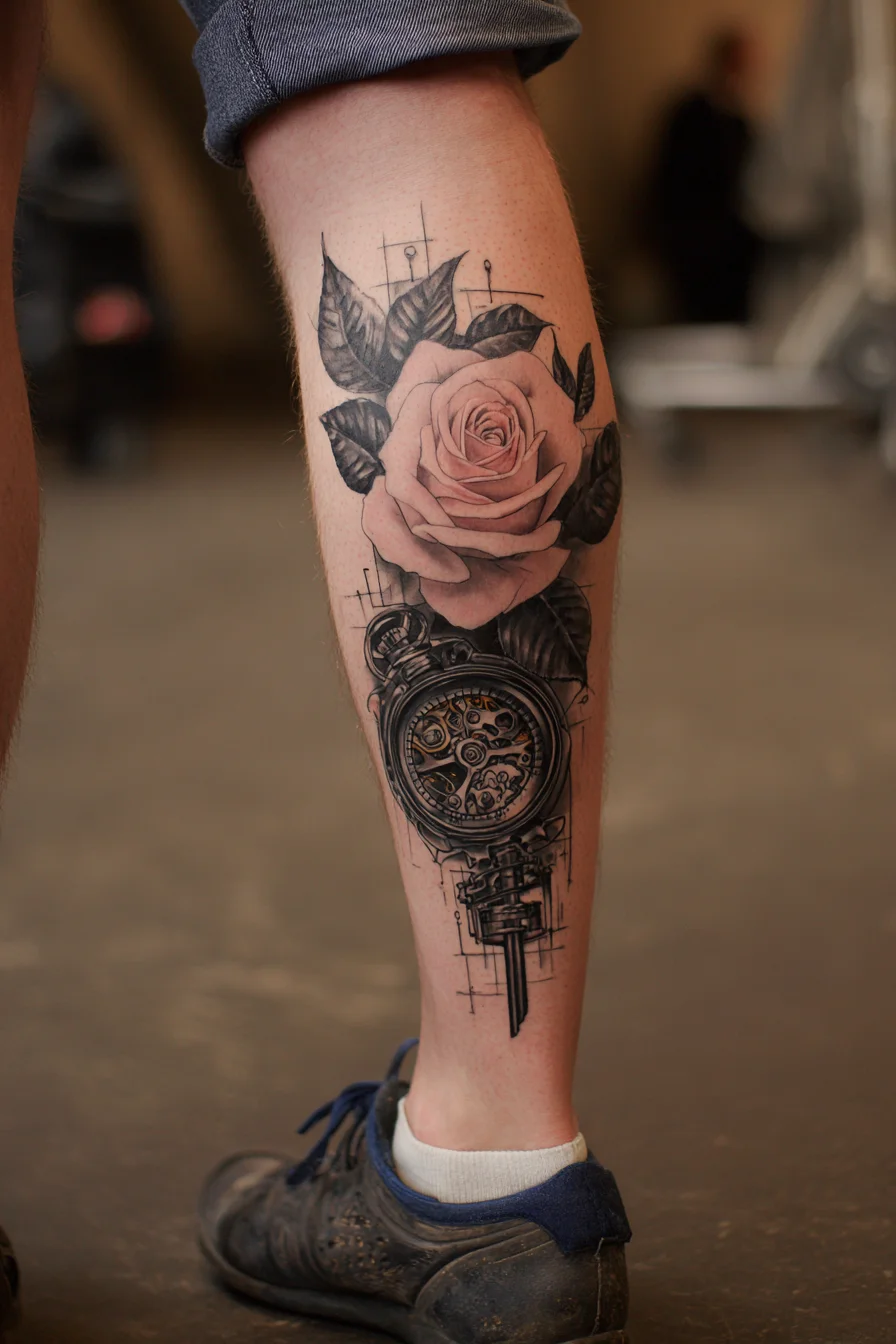
This composition pairs a realistic rose with an exposed mechanical pocket watch for a masculine, symbolic piece. The rose conveys themes of love, memory and growth, while the watch and visible gears speak to time, legacy, precision and resilience — a strong choice for men who want meaning combined with technical detail. Placement suggestions: the photographed calf is ideal for the vertical layout and allows the design to flow with the leg’s natural lines; alternatives include the forearm, outer bicep or thigh where elongated compositions work well. Pain expectations: expect moderate discomfort on the calf — the outer calf is among the less painful areas, while the inner calf and regions over bone (shin) will feel sharper. Size considerations: keep the tattoo medium to large (roughly 10–20 cm tall) so fine gear work and shading read clearly; downsizing requires simplifying mechanical elements. Styling variations: choose black-and-gray realism for a timeless look, add soft color for contrast in the rose, or incorporate geometric linework, dotwork or script (dates/names) to personalize. Discuss session breakdown and aftercare with your artist to preserve fine detail.
Regimental Bugler Realistic Calf Tattoo — Military Musician Design
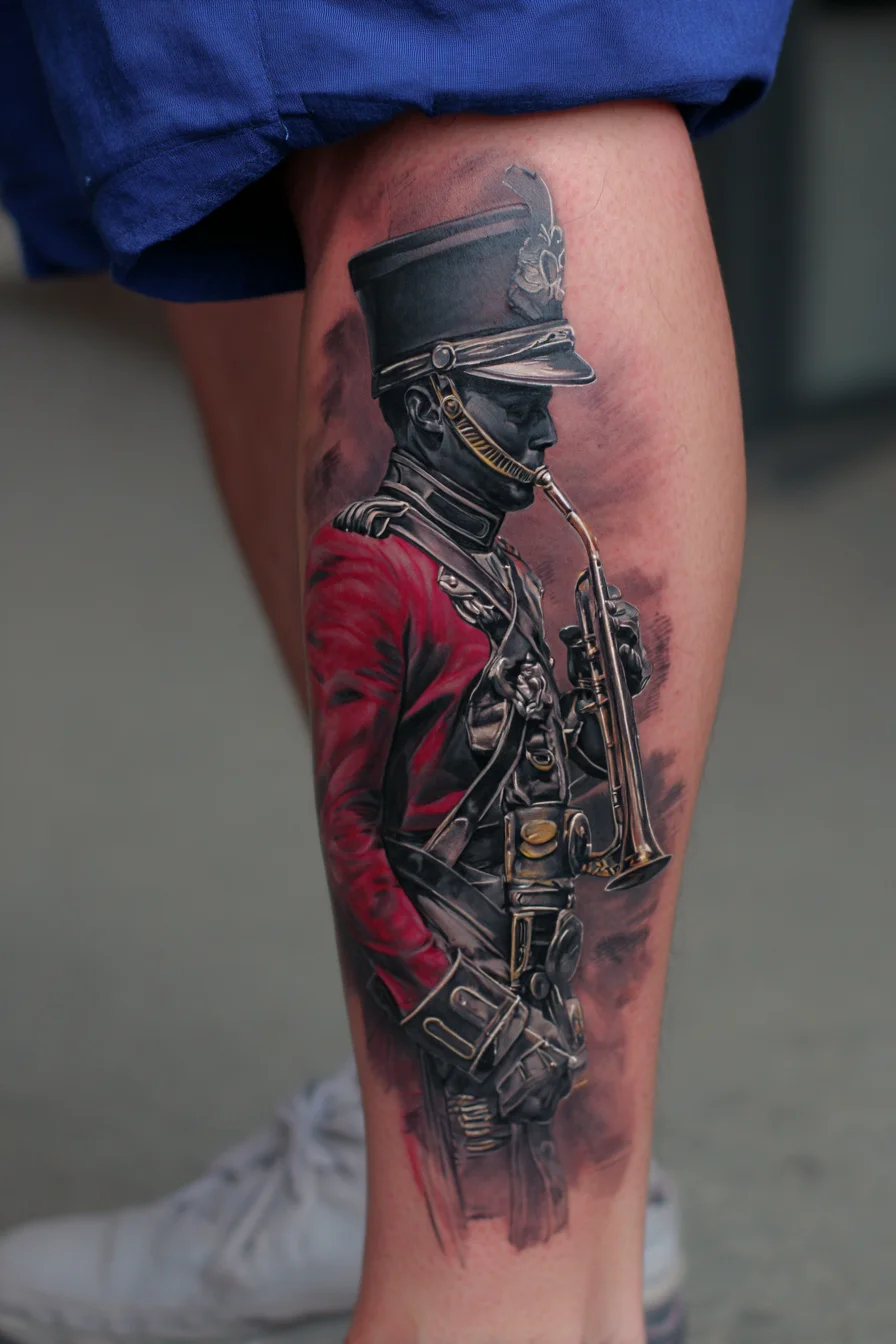
A realistic regimental bugler tattoo emphasizes discipline, tradition and ceremonial honor, making it a strong, masculine statement piece. The detailed helmet, brass instrument and red tunic read best at medium-to-large scale so line-work and metallic highlights remain crisp. Placement: the outer or inner calf (as pictured) suits the vertical composition, with the thigh, upper arm or side rib as alternative canvases; ribs and inner biceps will be more painful. Pain: expect moderate discomfort on the calf — outer calf is generally tolerable, inner calf and ribs are higher sensitivity zones. Size considerations: minimum 6–8 inches to preserve facial and instrument detail; full-leg or thigh versions allow expanded background and storytelling. Styling variations: photorealistic color with selective red and gold accents, monochrome black-and-gray for a vintage feel, or neo-traditional rework with bolder outlines. Consider adding background smoke, laurel, regimental numbers or geometric framing to integrate into a larger sleeve. For men, prioritize placement that fits your wardrobe and lifestyle — the calf offers concealability while still showcasing a powerful, narrative image.
Black & Grey Floral Calf Tattoo — Lotus/Peony with Cloud Shading
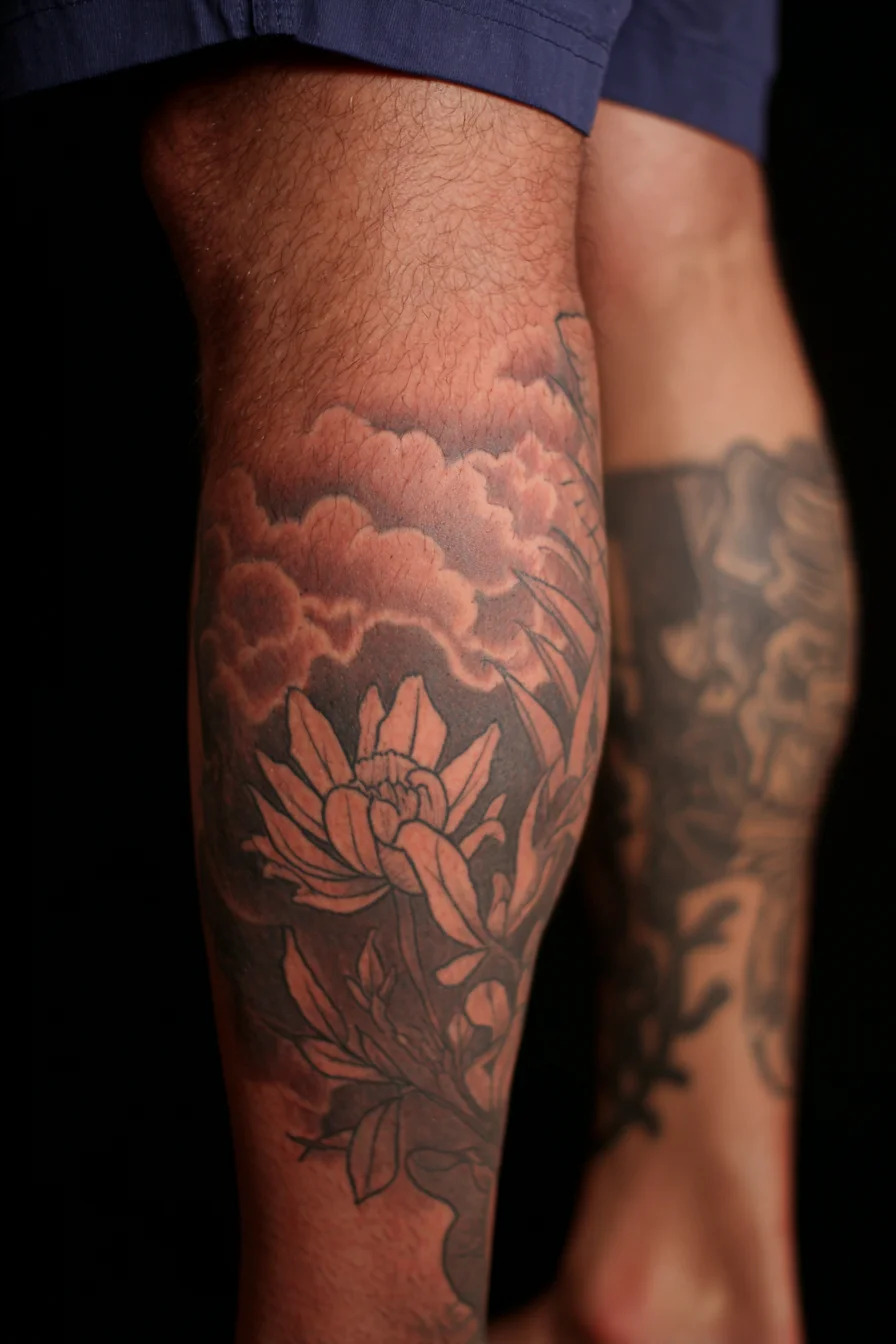
This black-and-grey floral piece pairs a lotus/peony motif with soft cloud shading for a masculine yet elegant statement. Symbolically it reads as resilience, renewal and controlled strength—qualities many men choose to express through floral imagery without losing a bold aesthetic. Placement: the outer calf is ideal to follow muscle flow and allow visibility; inner calf or thigh give a more private option, while the motif also scales well for a forearm or sleeve extension. Pain expectations: calf tattoos are generally moderate in discomfort — outer calf and meatier areas are less painful, inner calf and near the Achilles or shin register higher sensitivity. Size considerations: retain larger proportions (4–8+ inches) to preserve petal detail and cloud gradients; very small versions will lose subtle shading and linework. Styling variations: convert to full blackwork for higher contrast, add selective color accents (deep reds or ochres) for impact, or incorporate Japanese waves and bold outlines for an Irezumi feel. Discuss line thickness and shading depth with your artist to match your skin tone, lifestyle and desired longevity.
Blackwork Shin Tattoo: Mythic Mask with Filigree Vertical Design
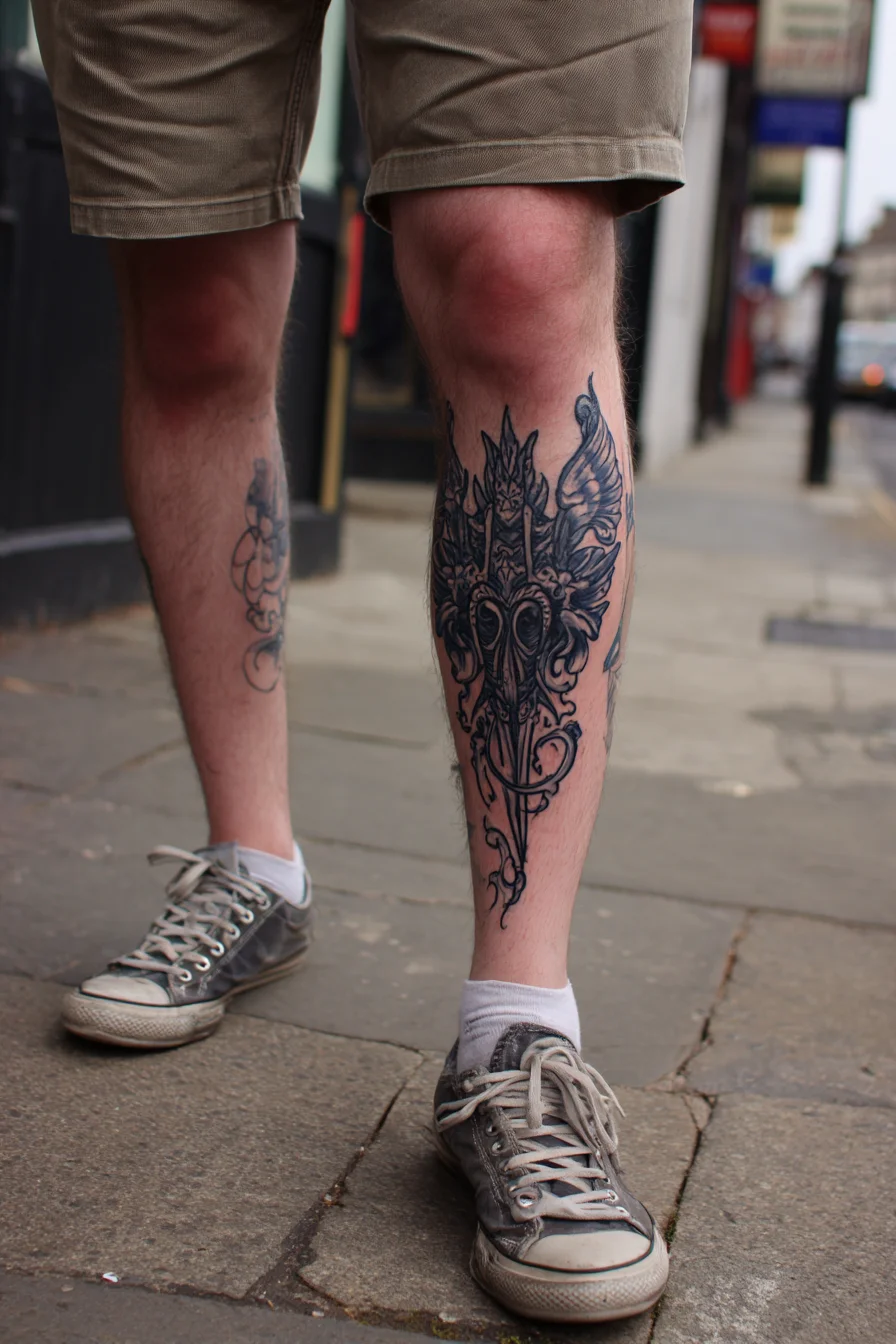
This ornate blackwork shin tattoo features a mythic mask motif framed by filigree and wing-like flourishes — a composition that reads as protection, stoic strength, and controlled aggression. Placement: the front or outer shin is ideal for the vertical layout where the design follows the tibia; it also integrates well into the calf or a full-leg sleeve. Pain expectations: the shin is a relatively sensitive area — expect sharp, localized discomfort directly over the bone and moderately less pain toward surrounding muscle and the inner calf. Size considerations: to preserve fine linework and negative-space detail, plan for a medium-to-large piece (roughly 15–30 cm / 6–12 in); smaller versions will lose intricacy, while larger scales allow deeper shading and easier blending with other pieces. Styling variations: keep it pure blackwork and dotwork for strong contrast, add limited color accents (red or gold) for focal points, or combine with tribal/Norse elements for a themed look. Aftercare and maintenance: heavy black fills age well but may need a touch-up in 1–3 years. Consult an artist experienced in ornamental blackwork to refine scale, contouring, and pain-management options.
Black & Grey Vintage Gentleman with Mechanical Bicycle — Calf Tattoo Idea
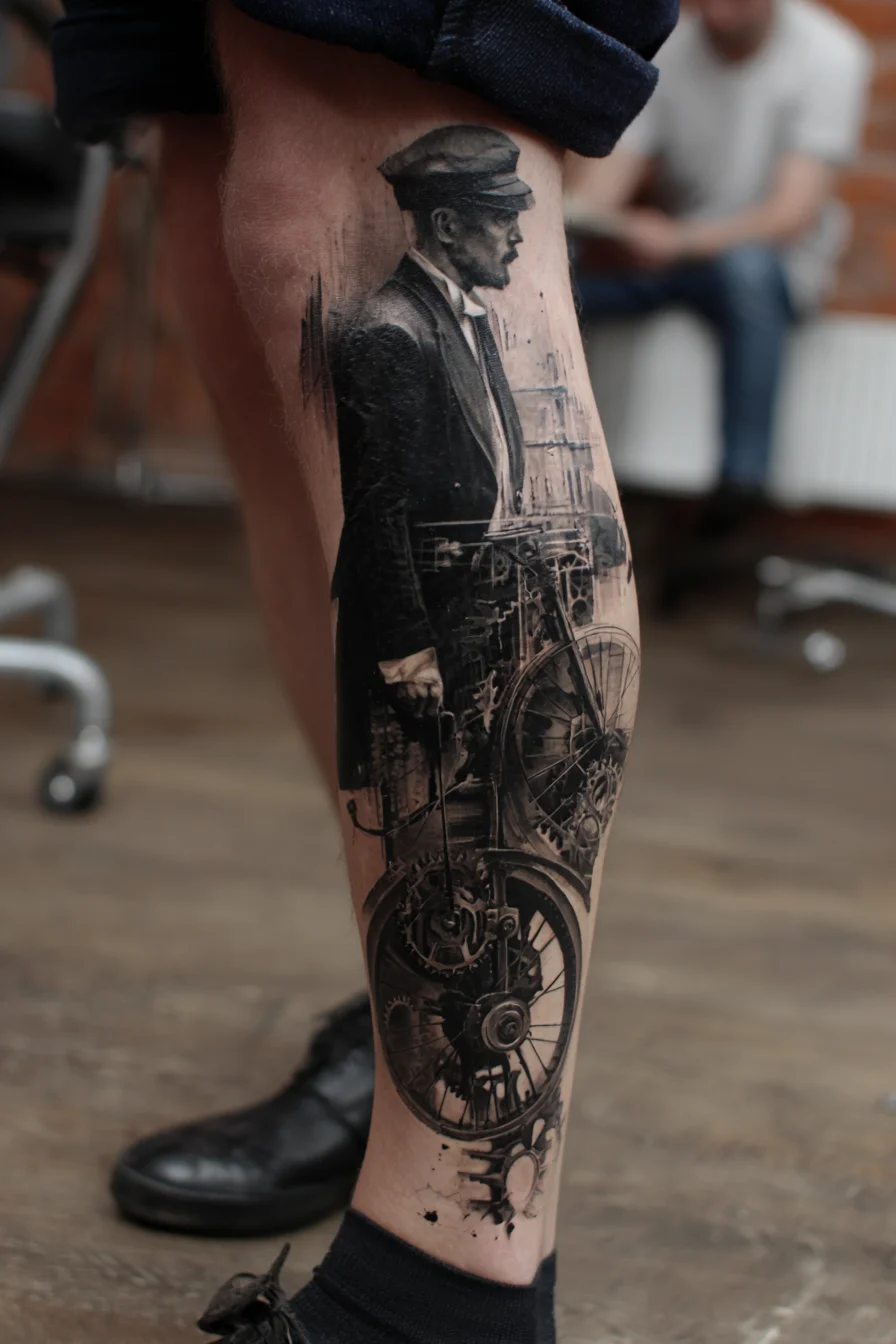
This black-and-grey, realism-driven tattoo pairs a vintage gentleman in period dress with intricate bicycle gears and mechanical elements — a symbolic blend of nostalgia, industry and personal journey. It reads as a portrait of resilience and craftsmanship: the human figure anchors identity while the machine imagery speaks to motion, time and inner mechanics. Placement: the outer or back calf (as shown) is ideal for vertical compositions and preserves detail while remaining easy to conceal; other strong options are the thigh or full forearm for increased visibility. Pain expectations: on the calf expect moderate discomfort — outer calf is less painful, while areas near the shin, ankle or behind the knee increase sensitivity. Size considerations: to keep facial features and gear work crisp, plan for a medium-to-large piece (roughly 6–12 inches vertically); smaller sizes will lose fine detail. Styling variations: maintain photorealism in strict black & grey, add sepia or rust-tone accents for a vintage feel, introduce watercolor splashes for contrast, or expand with geometric/gear backgrounds and script. Book an artist skilled in portraiture and mechanical linework to ensure longevity and legibility.
Baroque Filigree Blackwork Calf Tattoo — Ornamental Flourish Design
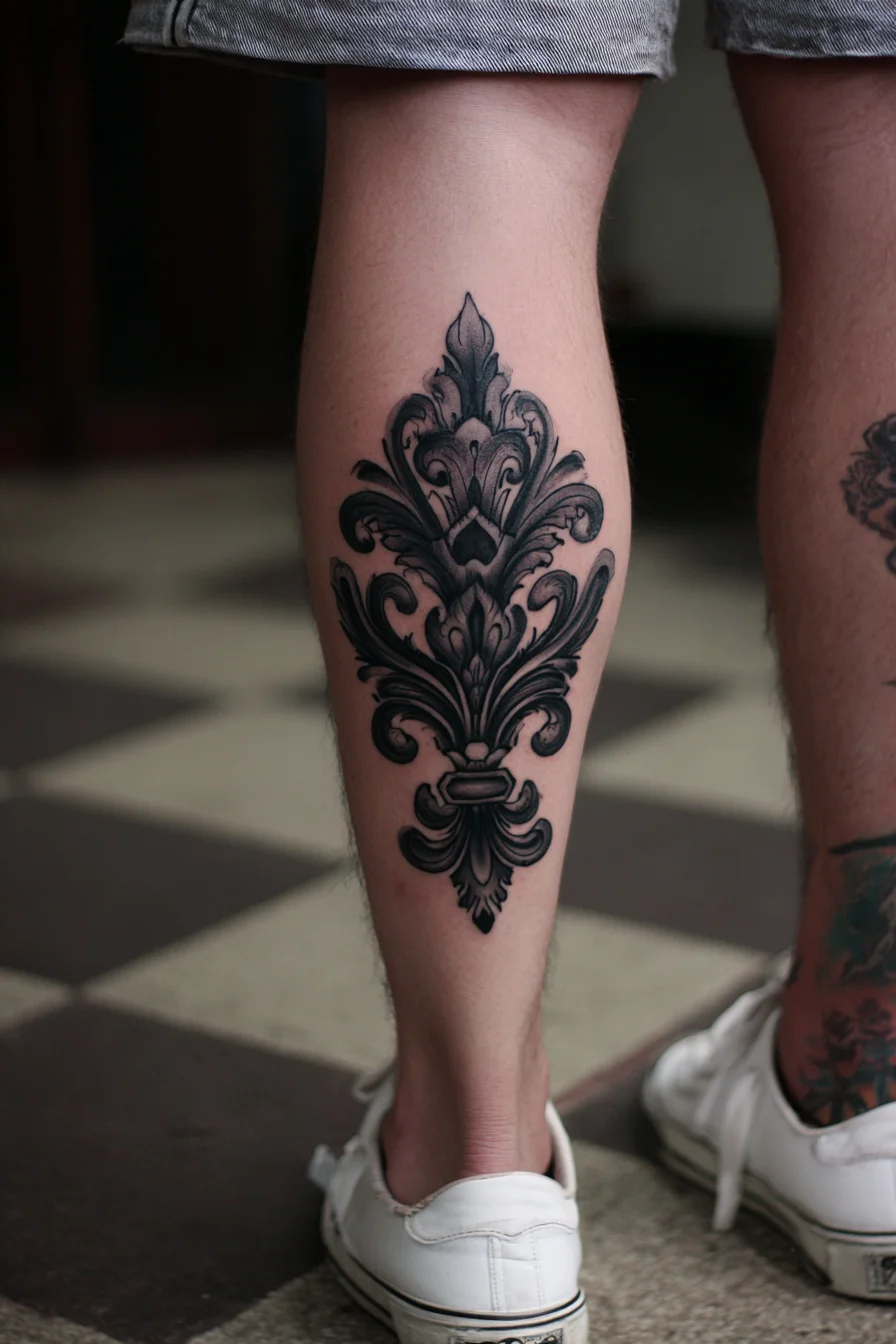
This bold baroque filigree tattoo is a masculine ornamental piece using heavy blackwork and smooth shading to create a three-dimensional flourish. Symbolically it reads as strength through structure — classic architectural ornamentation adapted to the body — and works well for men who prefer timeless, formal motifs rather than figurative imagery. Placement: the central calf is ideal for this vertical composition; outer calf offers better visibility and lower sensitivity, while the inner calf or wrapping around the leg creates a more intimate or dramatic effect. Pain & healing: expect moderate discomfort — the muscular outer calf is one of the easier leg areas, while the shin and tendon zones are noticeably sharper. Typical healing takes 2–3 weeks with aftercare; keep weight-bearing irritation minimal during initial healing. Size & detail: maintain enough scale so the carved shading and negative space read clearly over time — generally medium-to-large (roughly 4–8 inches tall) works best; very small versions will lose definition. Styling variations: go full blackwork like the image, add subtle color accents (deep reds or golds), convert to dotwork for texture, or integrate with sleeve-style thigh or ankle pieces for a cohesive leg layout.
Viking Warrior Calf Tattoo — Horned Helmet & Bearded Norse Portrait
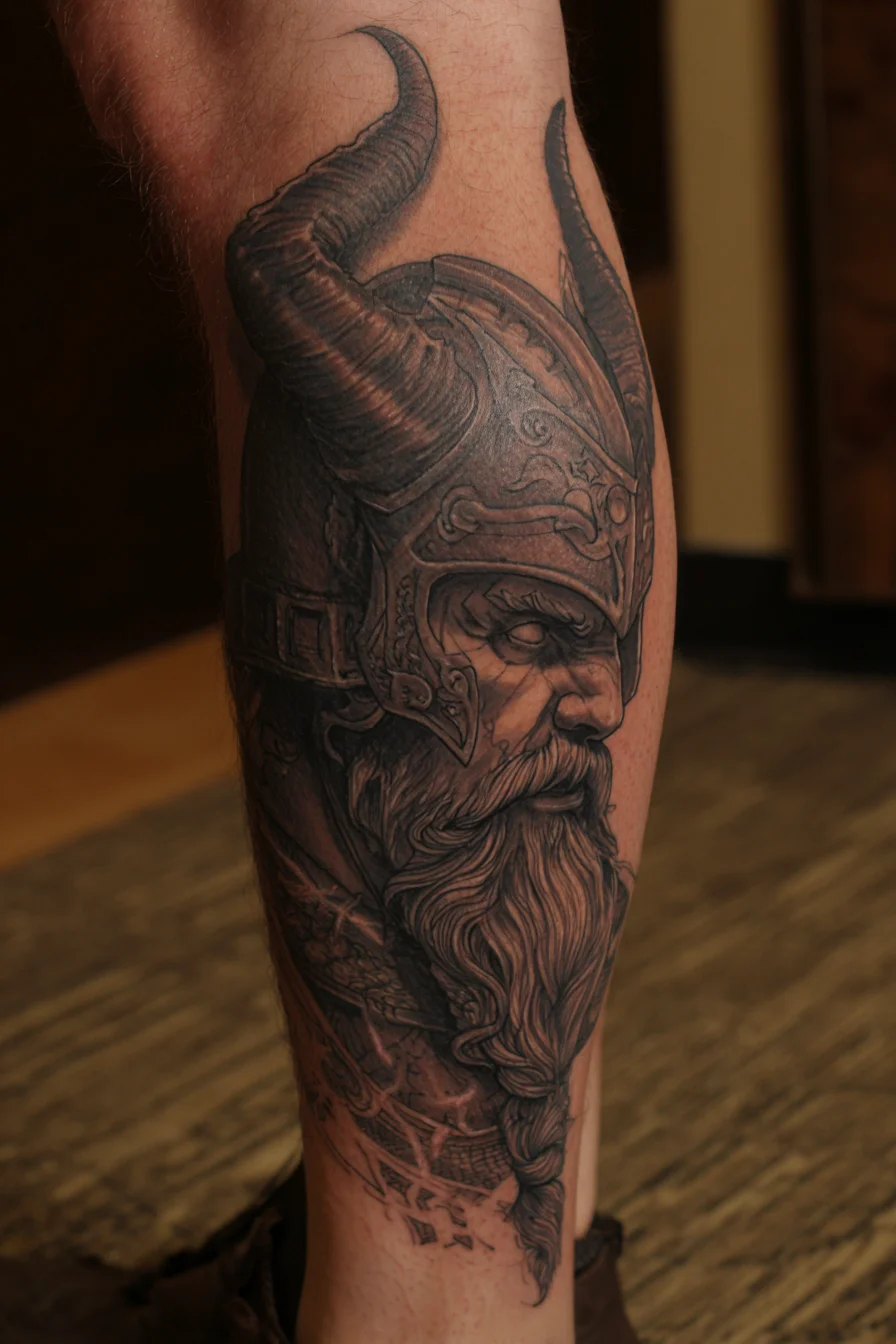
This detailed Viking portrait symbolizes strength, stoicism and a warrior’s code—ideal for men who want a bold emblem of resilience or ancestral inspiration. The helmet, braided beard and weathered features read clearly as themes of leadership, endurance and mythic heritage. Placement suggestions: the outer or full calf shown here works well because the vertical composition follows the muscle line and allows the face and braid to flow naturally; alternatives include a forearm sleeve, upper arm, thigh or back panel for larger scale. Pain expectations: outer calf is moderate in pain and tolerable for most; inner calf, ribs or shin will be noticeably more sensitive. Expect multiple sessions for lining, shading and touch-ups. Size considerations: to preserve fine details choose a medium-to-large layout — roughly 6–14 inches depending on placement — so facial features, helmet ornamentation and hair texture remain crisp. Styling variations: black-and-gray realism (as pictured) is classic; consider adding subtle color washes, Norse knotwork, runes, weapons or dotwork backgrounds for contrast. Commission an experienced realism artist to ensure depth, contrast and anatomical flow over the limb.
Realistic Tiger Calf Tattoo — Blue‑Eyed Tiger Portrait with Watercolor Accents
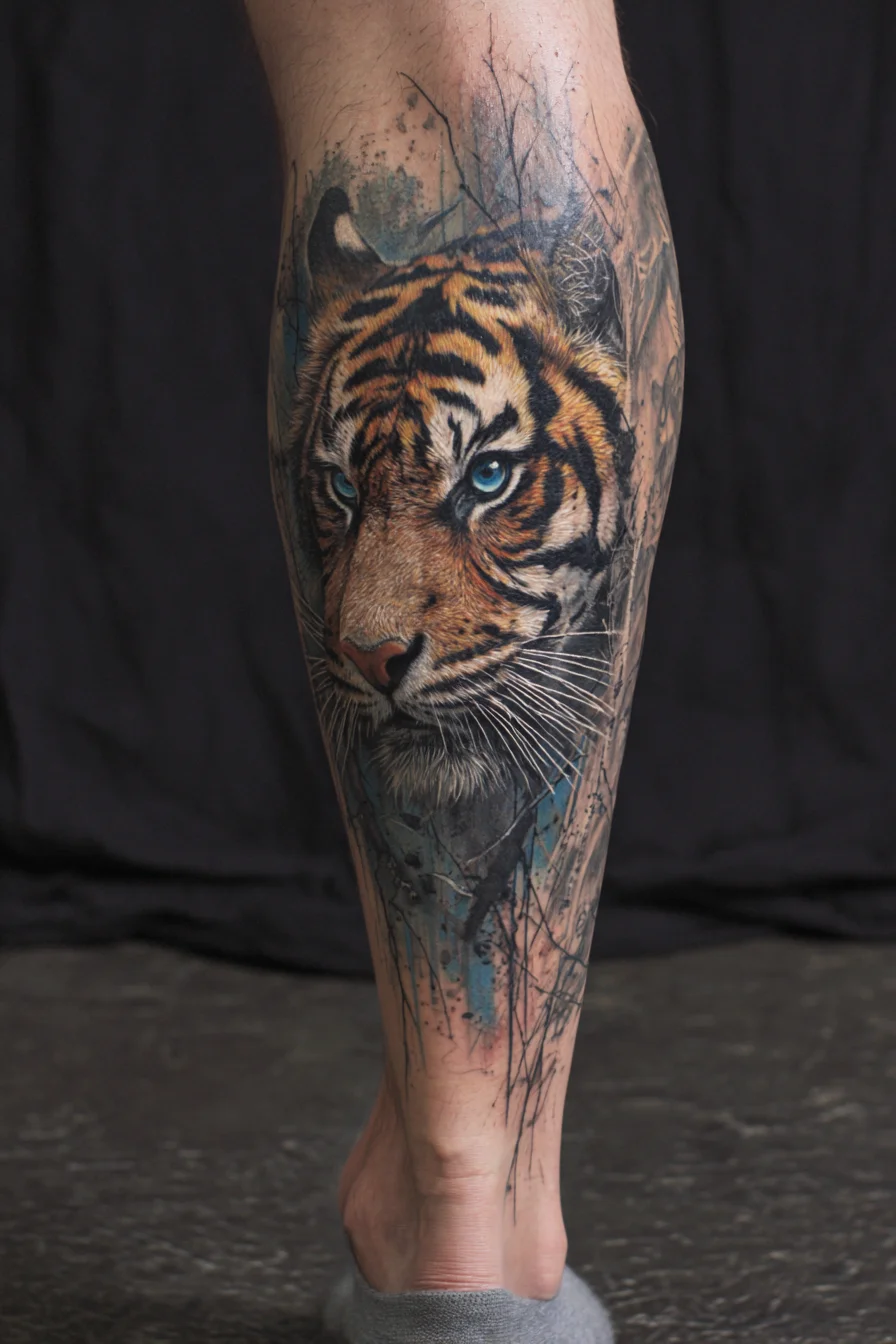
This realistic tiger portrait combines bold realism and watercolor splatter to convey power, focus and quiet ferocity—ideal for men who want a statement piece symbolizing strength, protection and personal drive. The blue eyes add a focal contrast that suggests intensity and clarity of purpose. Placement suggestions: the outer calf (as pictured) is excellent for an elongated portrait that follows muscle lines; other good options are the thigh, upper arm sleeve or side rib for larger-scale detail. Pain expectations: calves are generally moderate in pain—outer calf and fleshy areas feel less intense, while the inner calf, behind the knee and around the ankle/shin are more sensitive. Expect multiple hours in one session for color realism, with potential touch-ups. Size considerations: to preserve fine fur texture and eye detail go medium-to-large (roughly 6–12 inches / 15–30 cm); smaller sizes will lose realism. Styling variations: full-color realism, black-and-gray realism, or a hybrid with watercolor backgrounds; add geometric framing or dotwork for a contemporary twist. Ask your artist about needle grouping for fine whiskers and layered shading for lifelike depth.
Flaming Warrior Mask Calf Tattoo — 3D Metal Helmet, Flames & Ornate Filigree
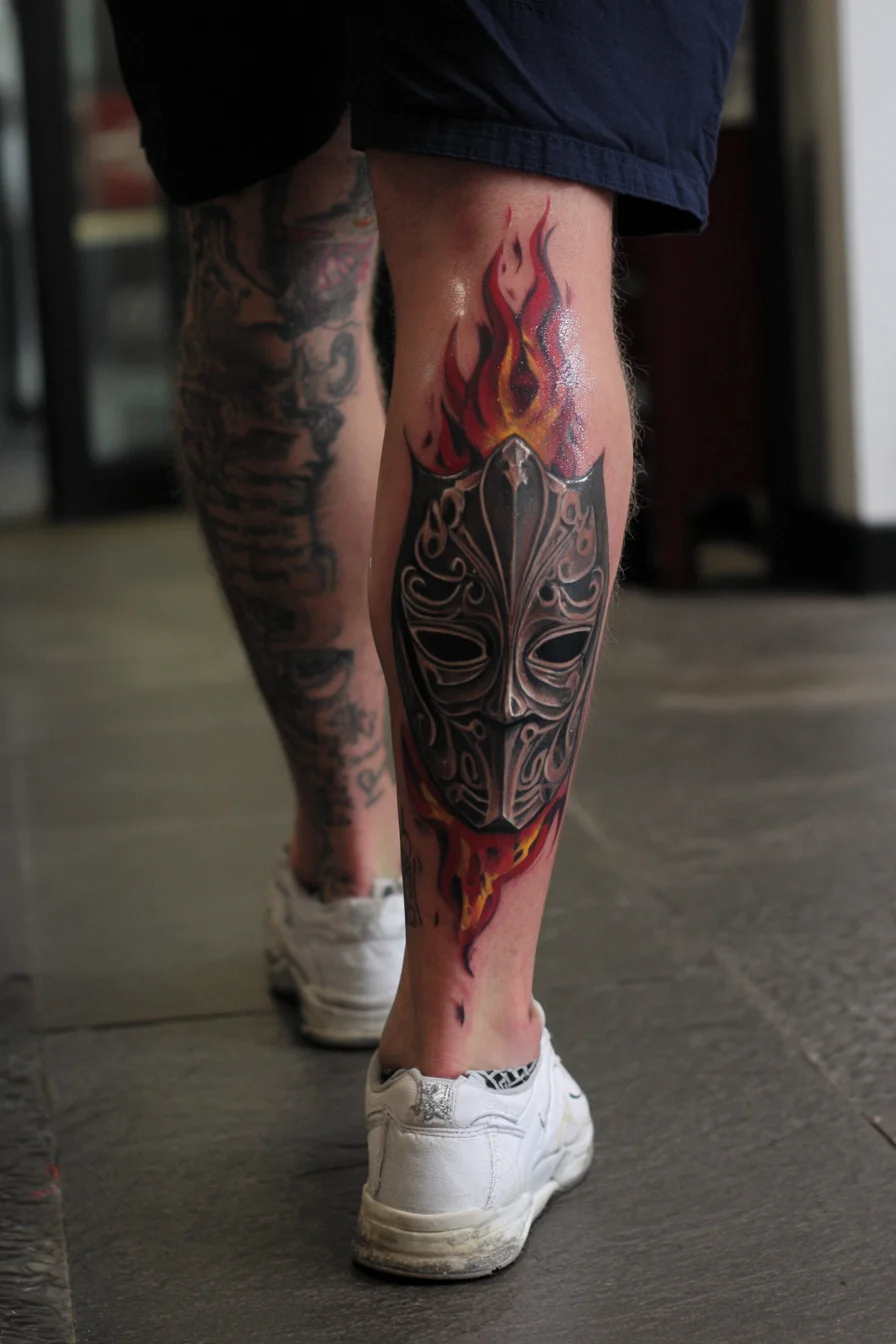
This design combines a detailed, ornamental metal mask or helmet with dynamic flames — a strong visual that reads as protection, warrior ethos and controlled aggression or rebirth. On the calf it becomes a masculine statement piece that balances realism with decorative filigree. For placement, the outer calf is ideal for visibility and easier aftercare; the inner calf offers a more private location, while wrapping toward the ankle or knee creates a compelling leg-sleeve flow. Expect a moderate pain level overall: fleshy outer calf areas are tolerable, but the shin, ankle and behind-the-knee regions are significantly more sensitive. Size matters for clarity — plan medium to large (roughly 6–12 inches tall depending on your calf) so fine metalwork and shading read well on curved skin. Stylistically you can lean into hyper-realistic metallic highlights and deep blacks, a colored flame palette for contrast, or neo-traditional bold lines for longevity. Consider adding Norse runes, distressed textures or watercolor backgrounds to personalize the theme. Consult your artist about session splits, curvature mapping and aftercare for optimal healing and detail retention.
Baroque Acanthus Calf Tattoo — Ornamental Blackwork for Men
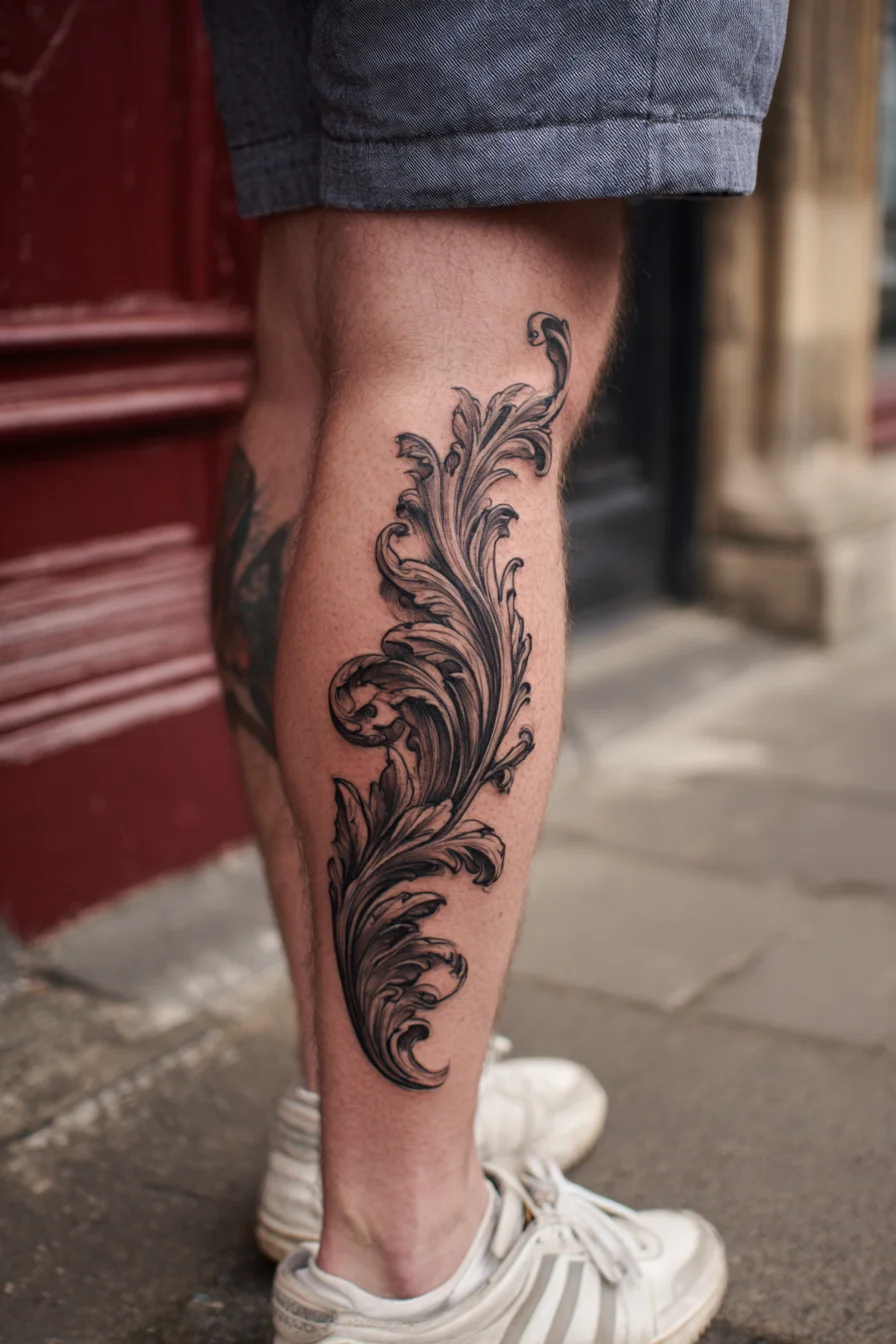
This flowing acanthus/Baroque ornamental design reads as a statement piece that blends classical symbolism with modern blackwork. Meaningfully, acanthus foliage suggests resilience, growth and timeless craftsmanship — a good choice for men who want a refined, masculine motif without overt imagery. Placement suggestions: the outer or posterior calf is ideal because the elongated vertical shape follows muscle lines; alternatives include the forearm, rib cage (for wrap effect), thigh or as a vertical element in a sleeve or leg-piece. Pain expectations: calves are generally low-to-moderate on the pain scale — the outer calf tolerates sessions well, while the inner calf, behind the knee and near the ankle or shin can feel sharper. Size considerations: the design benefits from a longer, narrow layout (roughly 15–30 cm / 6–12 in) to preserve detail and flow; larger scale improves shading and longevity. Styling variations: pure blackwork with bold contrast, fine-line engraving, dotwork shading, or subtle color accents (deep green or gold) all work; you can also add negative-space highlights, script elements or integrate with geometric backgrounds for a contemporary edge.
Norse Viking Knotwork Calf Tattoo — Intricate Tribal Leg Sleeve
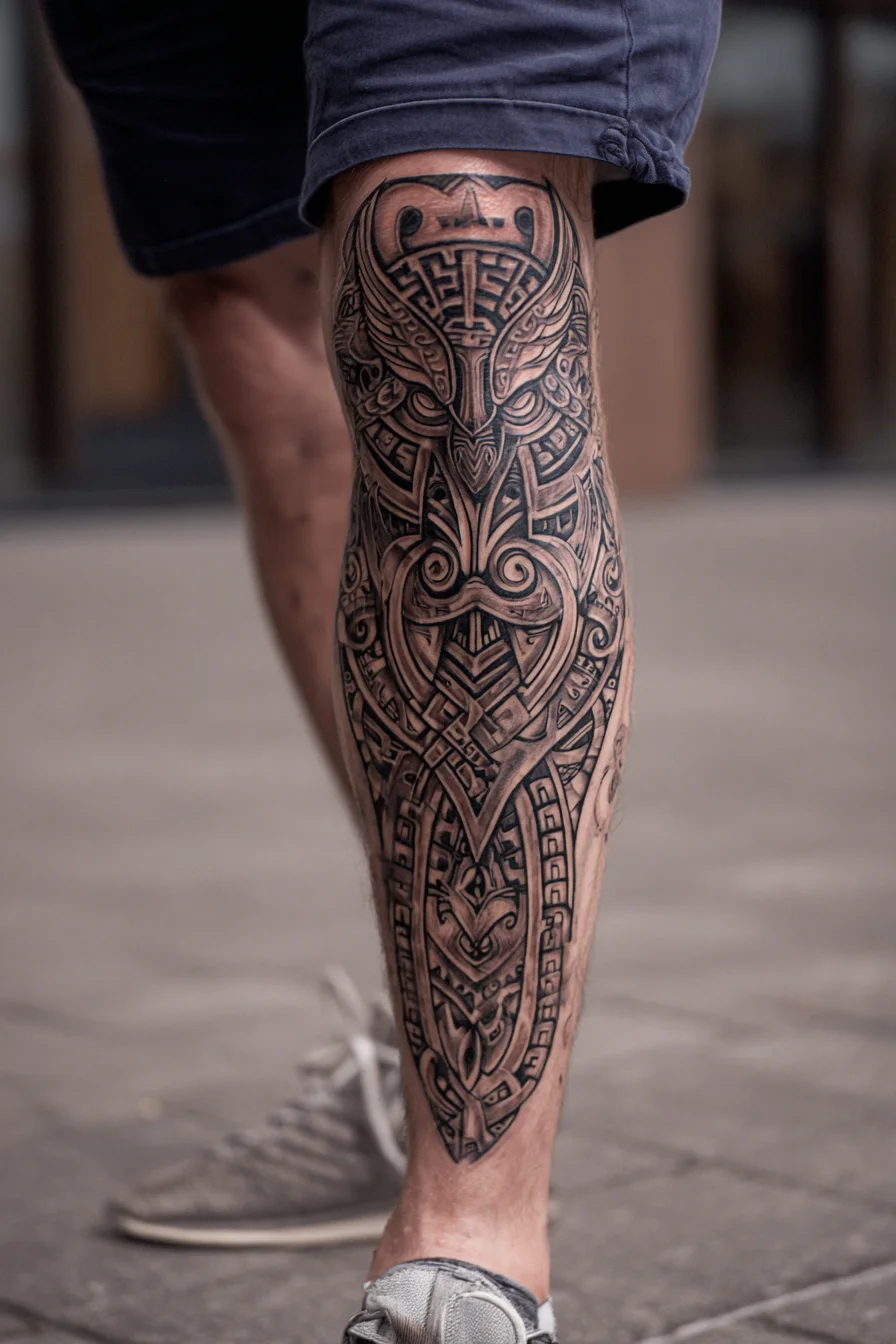
This calf-length Norse/Viking-inspired leg sleeve combines bold knotwork, mask/helm imagery and ornamental linework to convey protection, warrior spirit and ancestral connection. Placement works best on the outer or full calf where the vertical composition follows muscle lines and reads well in motion; it can be extended into a half- or full-leg sleeve to balance thigh mass. Pain expectations are moderate across the fleshy calf, with higher sensitivity over the front shin, ankle and behind-the-knee areas — plan for multiple sessions and short breaks. Size considerations: the design benefits from an elongated layout (roughly 8–14 inches), leaving enough negative space so intricate knotwork doesn’t blur with time; keep major elements wide enough (3–4+ cm) for longevity. Expect 2–5 sessions depending on density and shading. Styling variations include pure blackwork for a stark, masculine look, dotwork or subtle graywash for depth, and selective color or metallic accents (deep red, indigo, gold) for contrast. Work with an artist experienced in Norse motifs to tailor line flow to your leg anatomy and personal meaning.
Norse Sword Calf Tattoo — Viking Knotwork Dagger Design
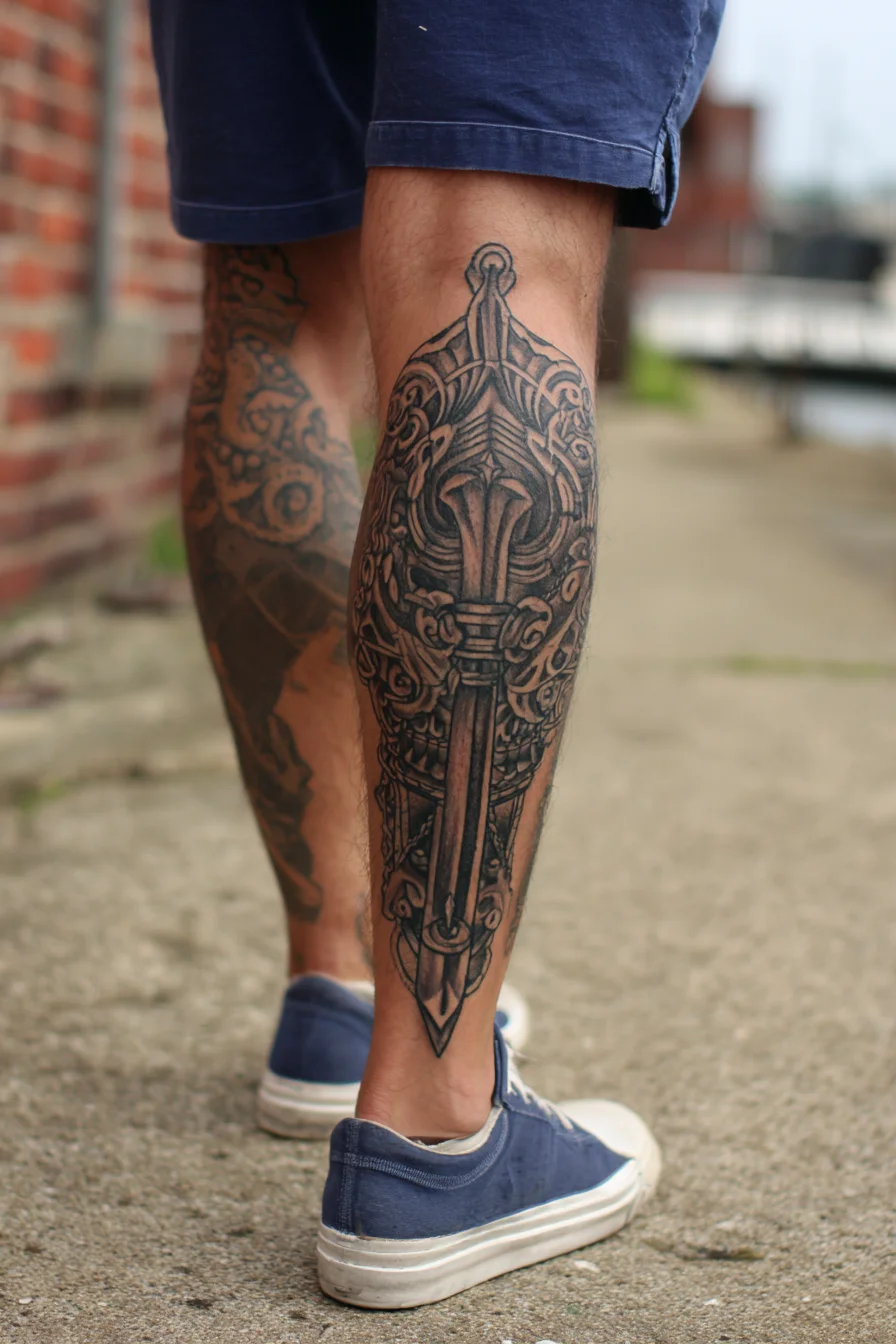
Clean, vertical Viking sword and Norse knotwork motif designed for the calf. The sword/dagger symbolizes protection, discipline, and warrior heritage; knotwork adds continuity and timelessness, making it a masculine emblem that reads well at a distance and up close. Placement: ideal on the outer or inner calf where the vertical form follows muscle lines; also adapts to the shin, outer thigh, or forearm for scaled versions. Pain expectations: calf skin generally rates moderate — outer calf less sensitive, inner calf and over the shin/ankle are more painful. Expect intermittent soreness and throbbing during longer sessions, especially when shading dense blackwork. Size considerations: full lower-leg pieces work best at 6–12 inches to preserve detail; smaller versions (3–5 inches) lose fine knotwork and should simplify linework. Styling variations: black-and-grey realism, heavy blackwork for bold contrast, dotwork or stippling for texture, subtle color accents (rusty bronze or muted blue) to emphasize the blade, or integrate runes and background flourishes for a sleeve transition. Discuss stencil placement and session planning with your artist to match anatomy and desired longevity.
## Neo-Traditional Rose & Dagger Calf Tattoo
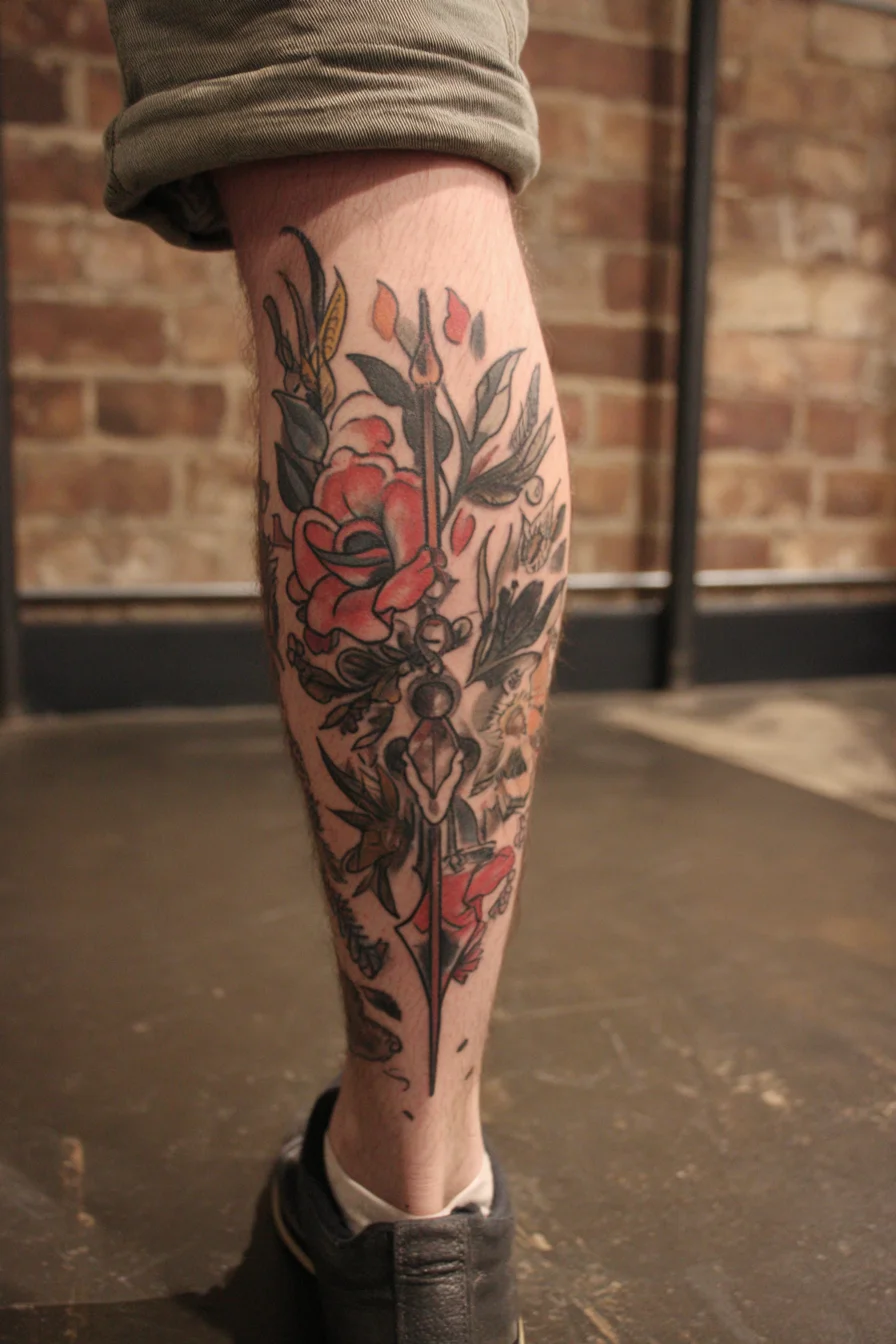
This neo-traditional rose-and-dagger piece combines classic symbolism — passion, sacrifice and protection — with bold linework and saturated reds for a masculine, timeless look. The dagger running vertically through roses creates a clear narrative of contrast: beauty versus danger, commitment versus struggle. Placement suggestions: the calf or outer lower leg is ideal for this long, narrow composition; it reads well standing or sitting and can be expanded into a half- or full-leg sleeve. Pain expectations: the fleshy calf is generally moderate in discomfort and tolerable for most men, while areas closer to bone (shin, ankle, inner calf) will be noticeably more painful. Size considerations: keep the dagger and floral elements tall enough to preserve detail — typically a vertical piece of at least 5–8 inches works well; larger sizes allow for richer shading and background work. Styling variations: maintain the neo-traditional look with bold black outlines and solid color, switch to black & gray for a subtler tone, or add dotwork, geometric backgrounds, or watercolor washes for a modern twist. Discuss artist experience with leg placement and aftercare to ensure crisp long-term results.
As a consultant who has guided hundreds of men through leg tattoos, my recommendation is simple: plan, prioritize anatomy, and partner with the right artist. Start with a clear concept and reference images (youll find 24 examples here), consider how the piece interacts with calf and thigh muscles, and pick a style that matches your daily wear and grooming. Schedule tattoos in manageable sessions, allow full healing between passes, and follow aftercare instructions – cleaning, moisturising, sun protection and limited strenuous movement are key. For hairy legs discuss shaving or adaptation with your artist; for darker skin choose contrast and bold line work. Dont rush coverups or enlargements – consult a color-correcting artist first. If youre unsure, book a short consultation to test placement with stencils. Im Hakan – open to helping you refine ideas, choose artists, and ensure your leg tattoo becomes a lasting, wearable piece.
